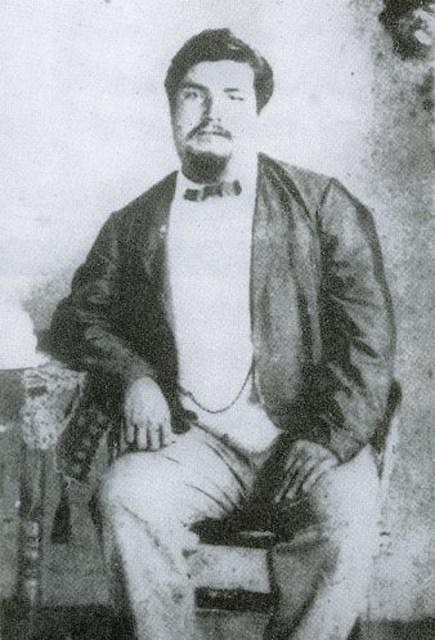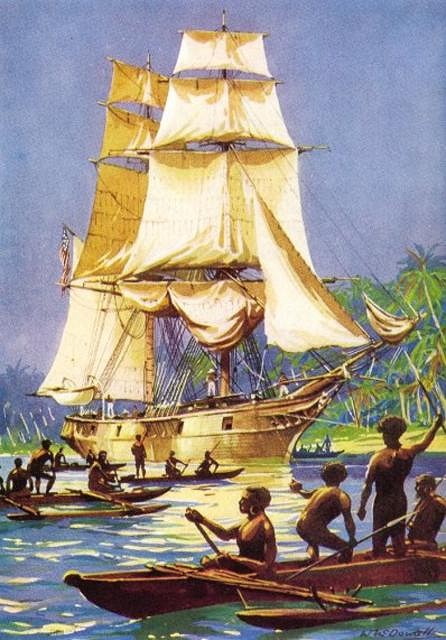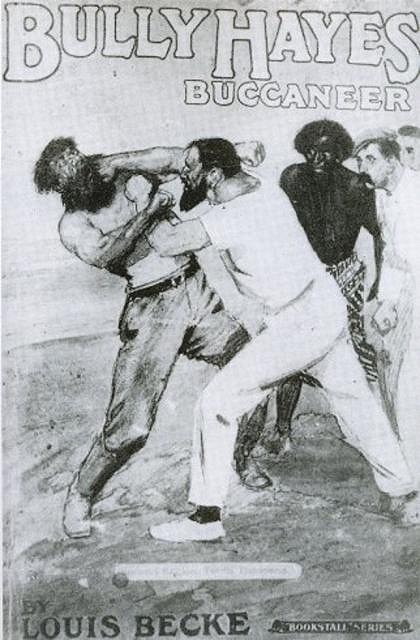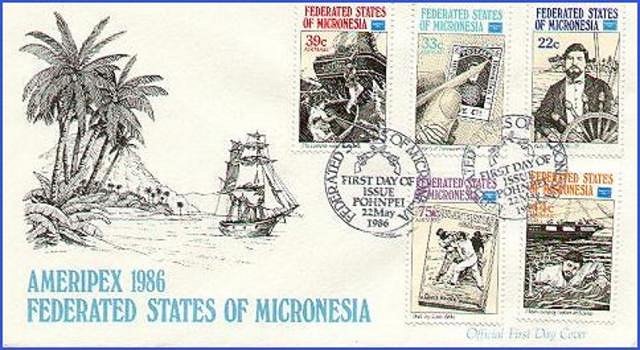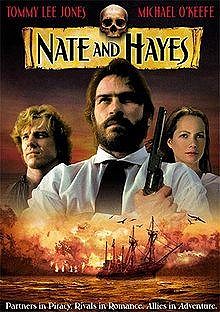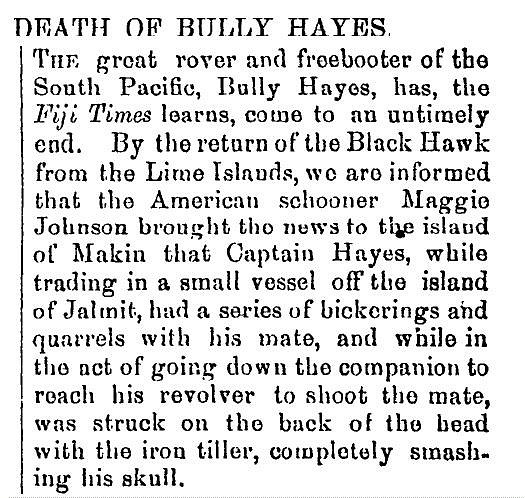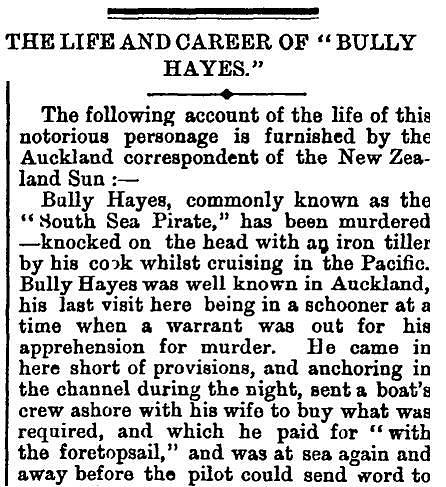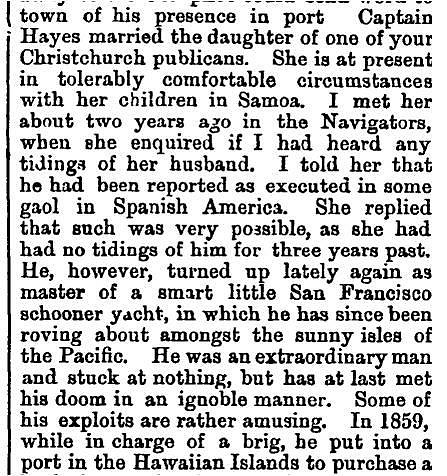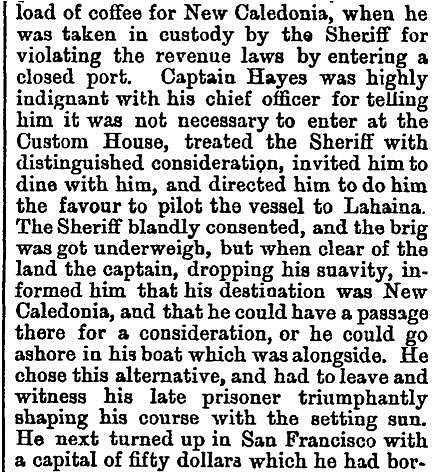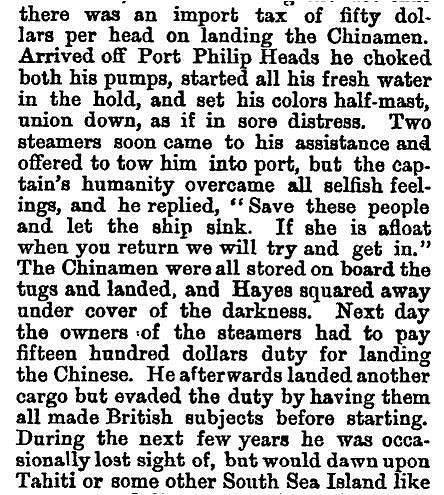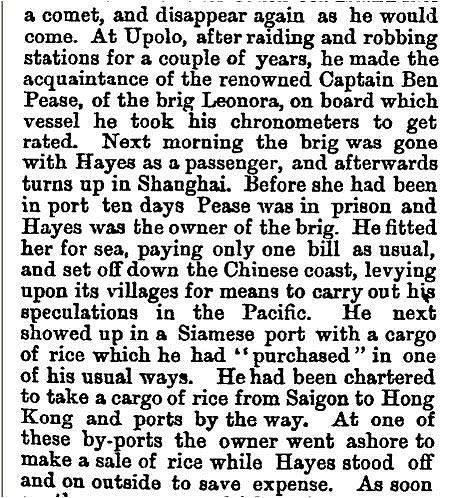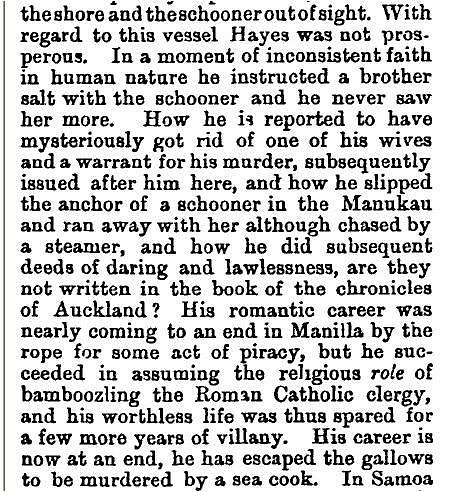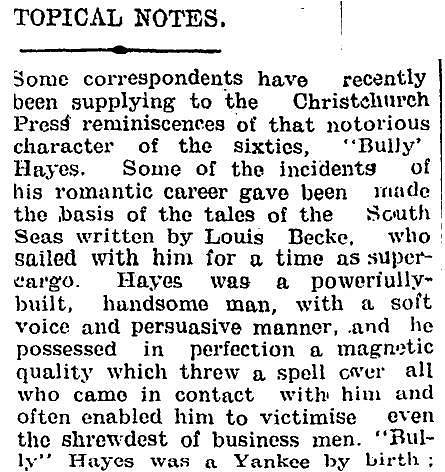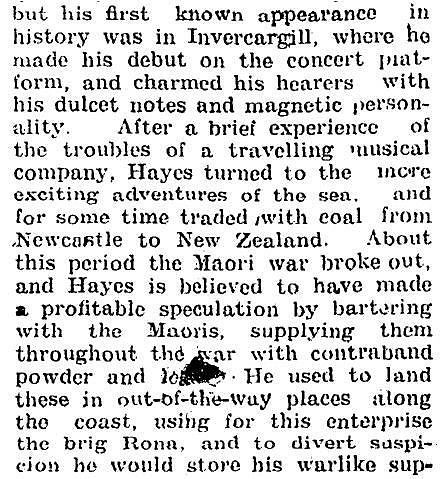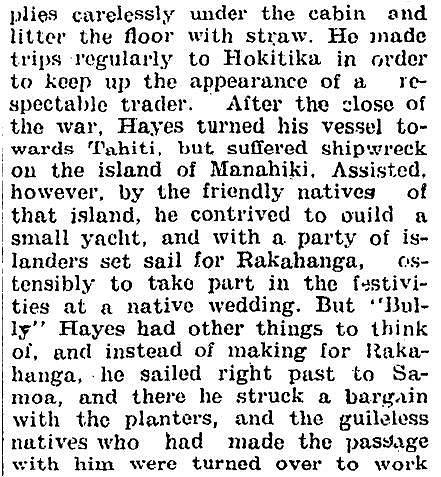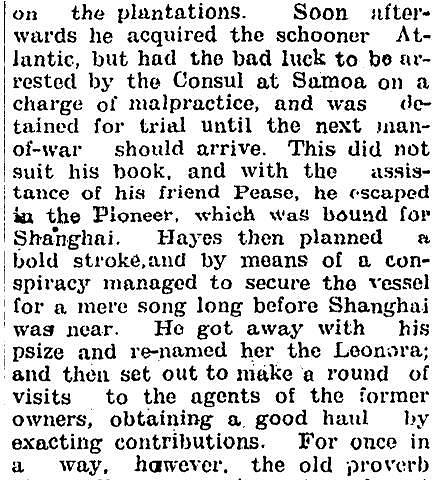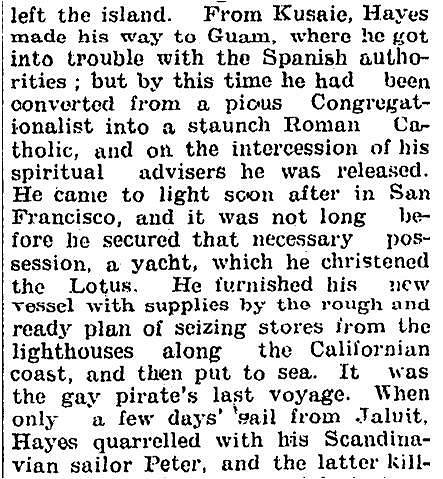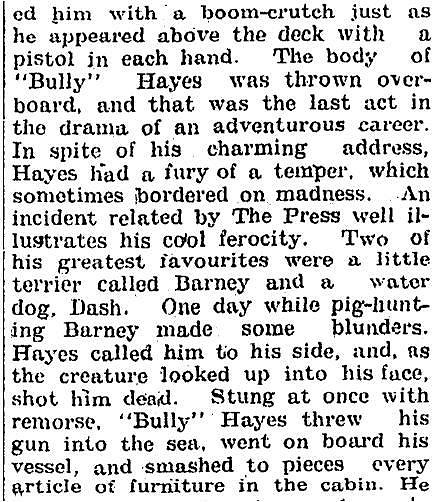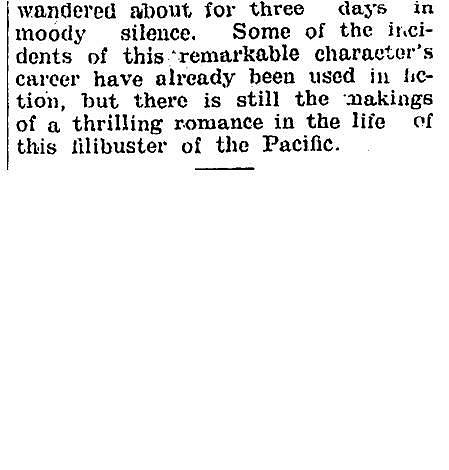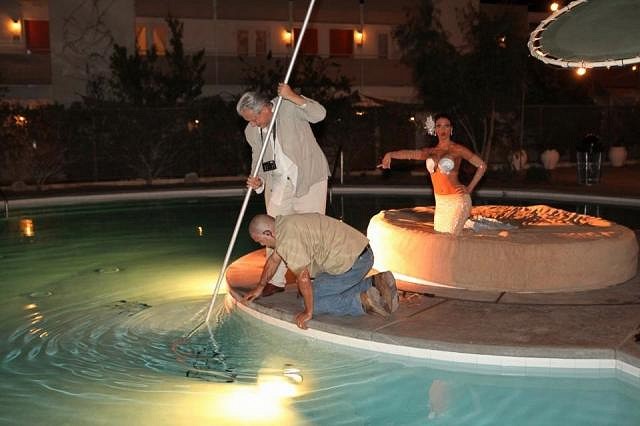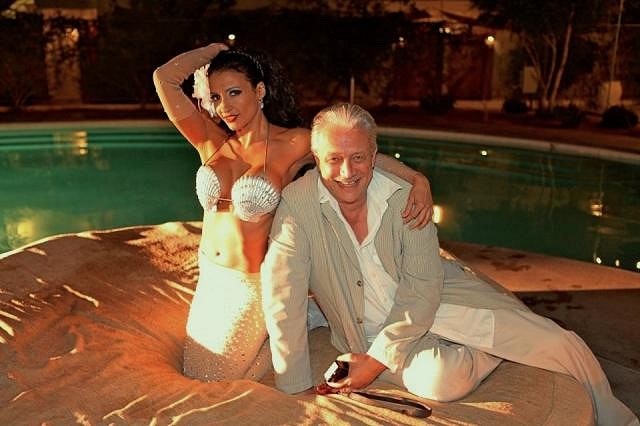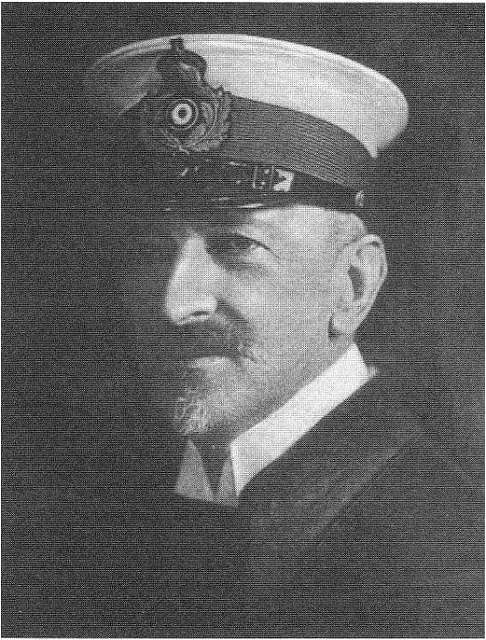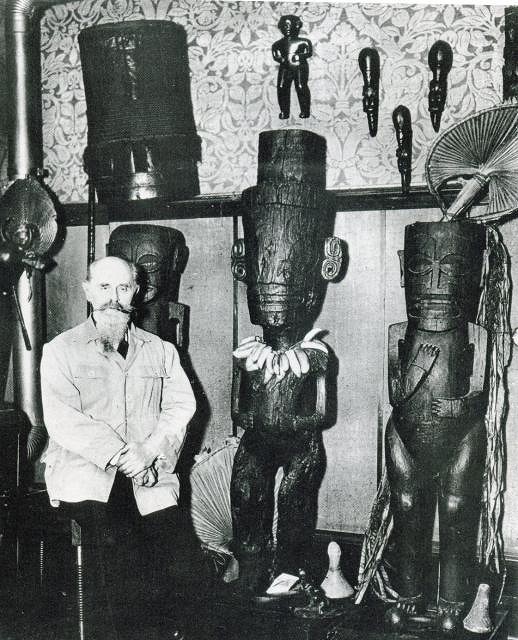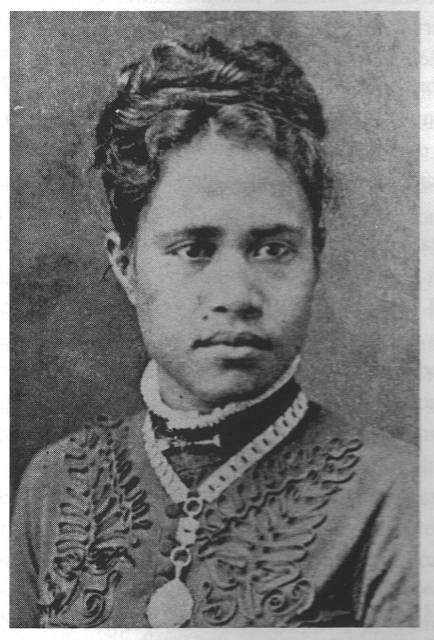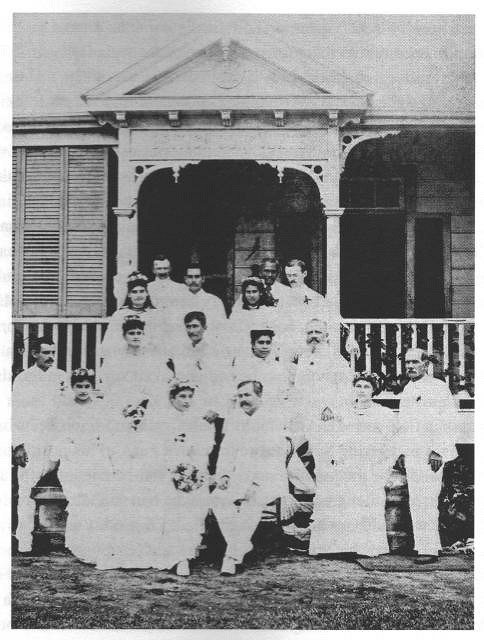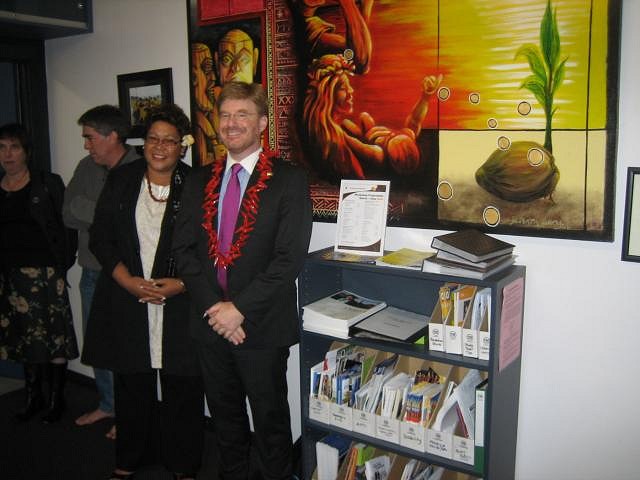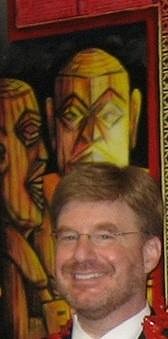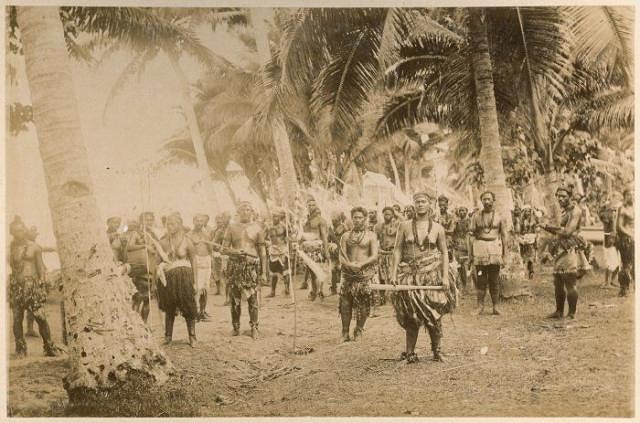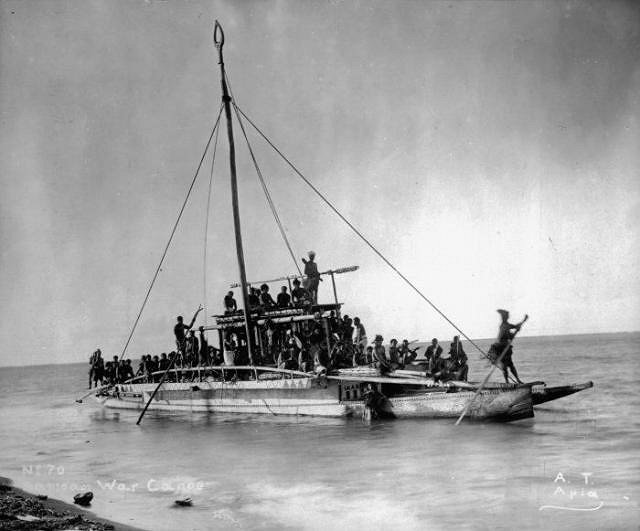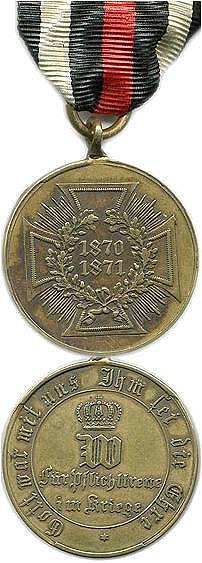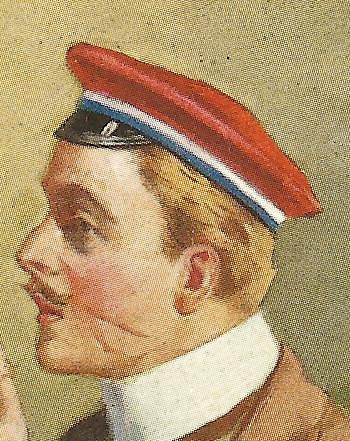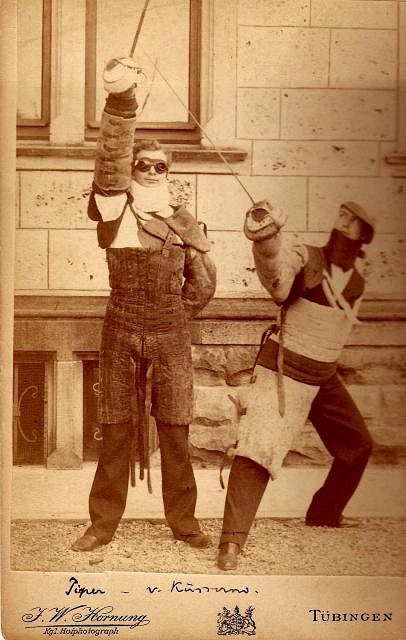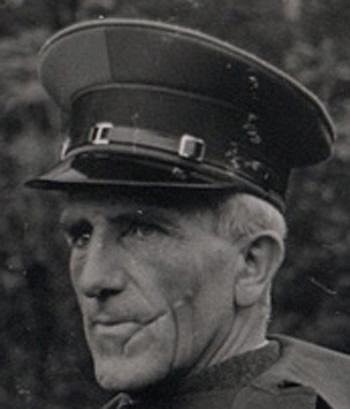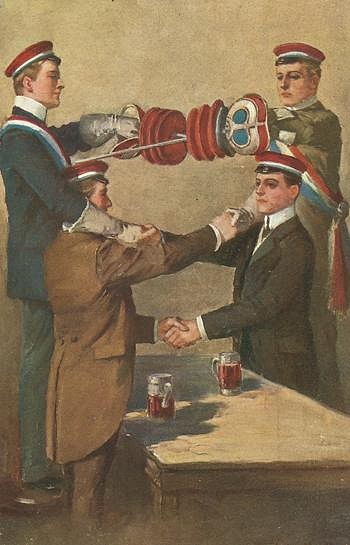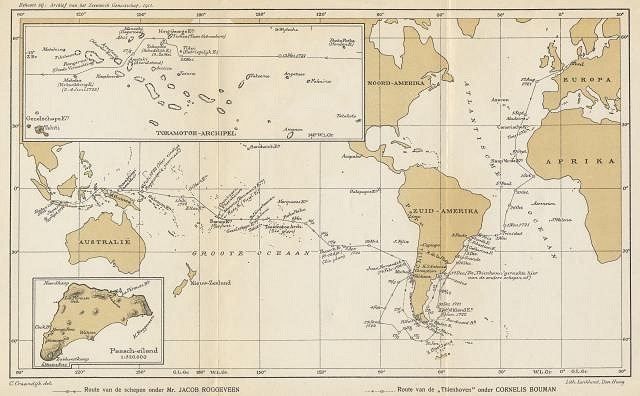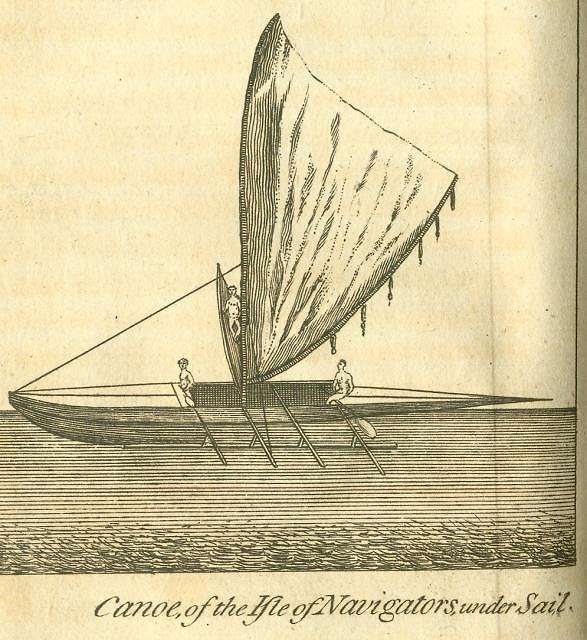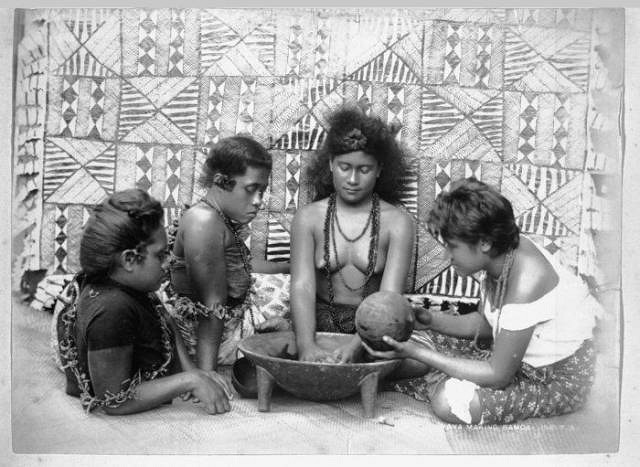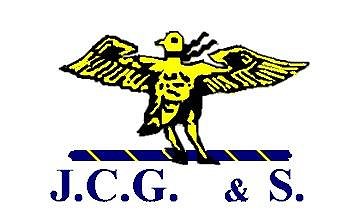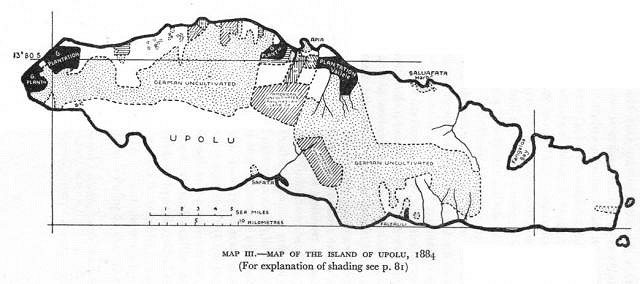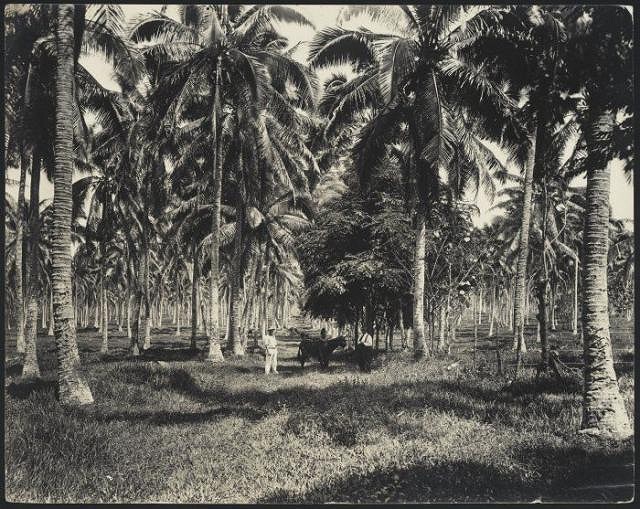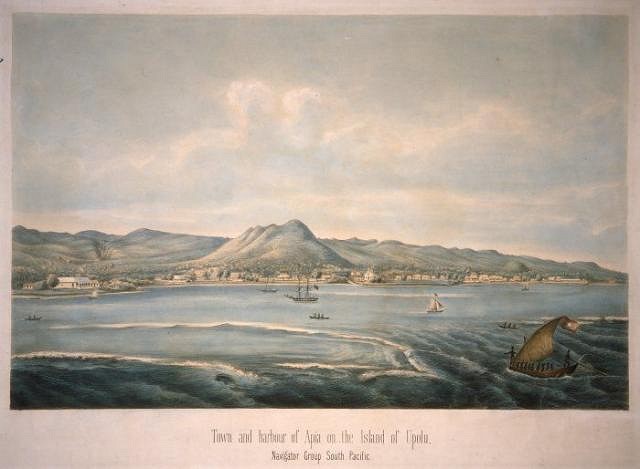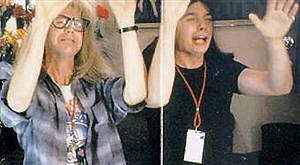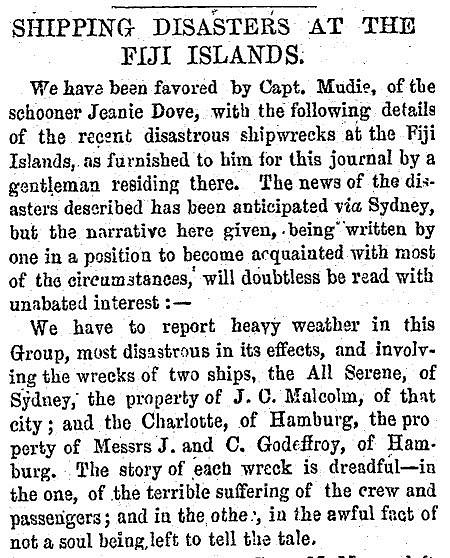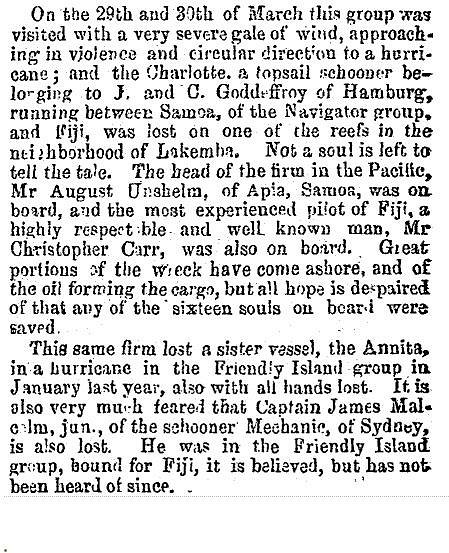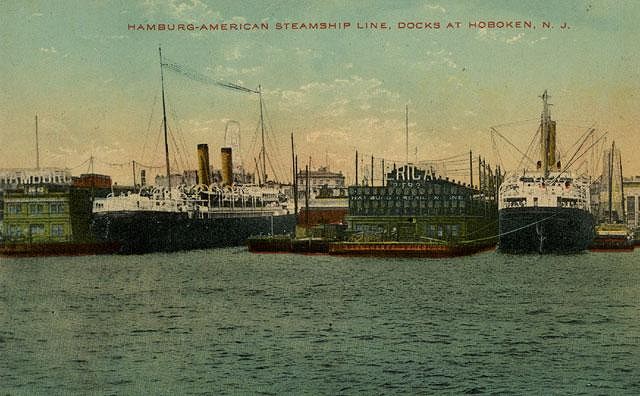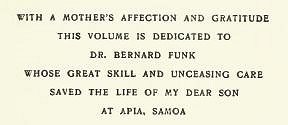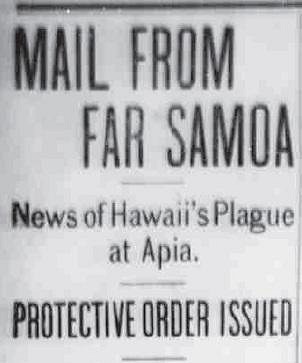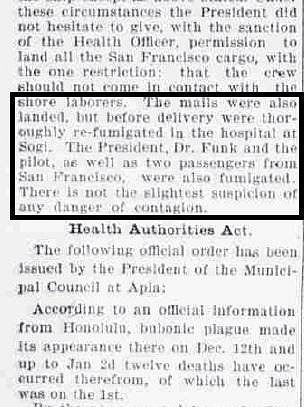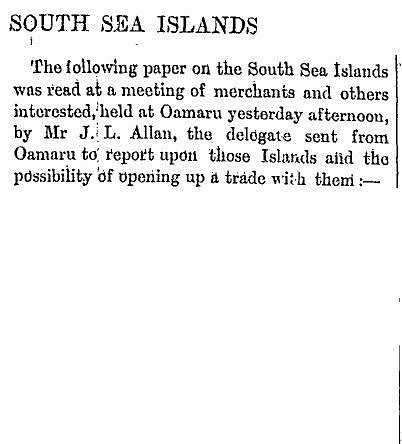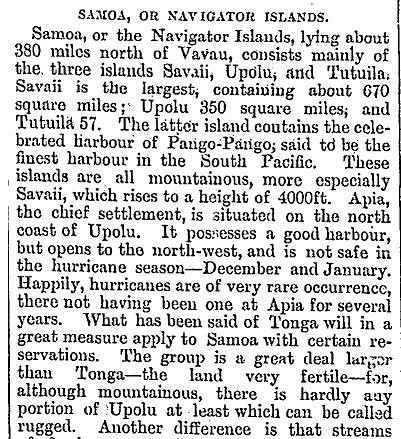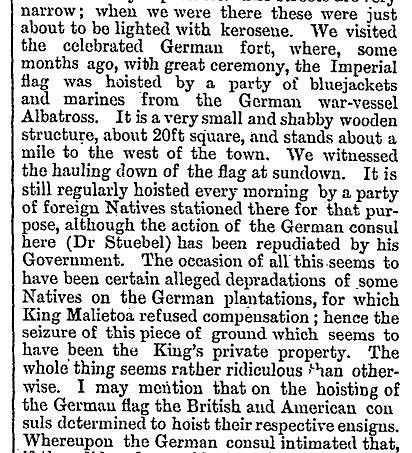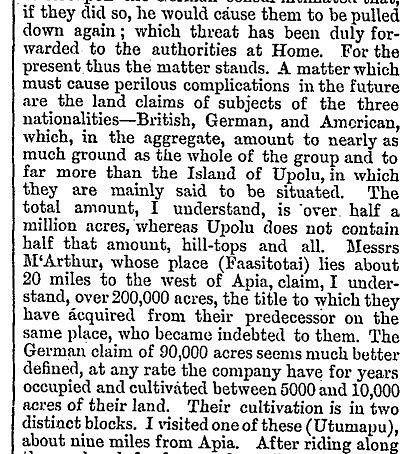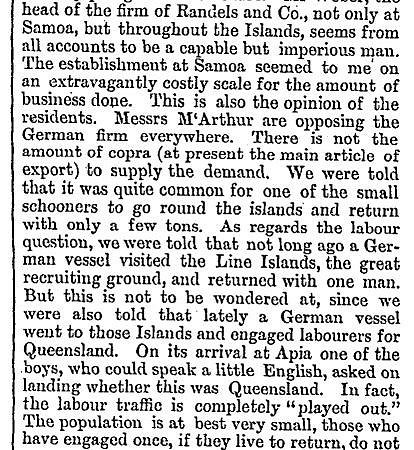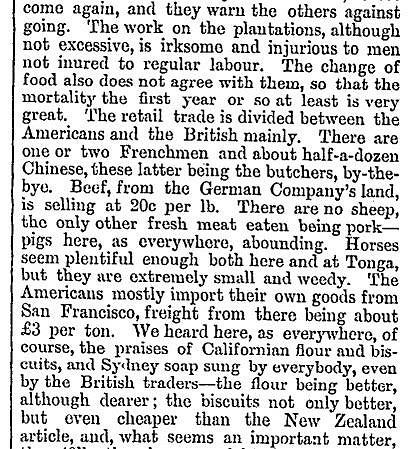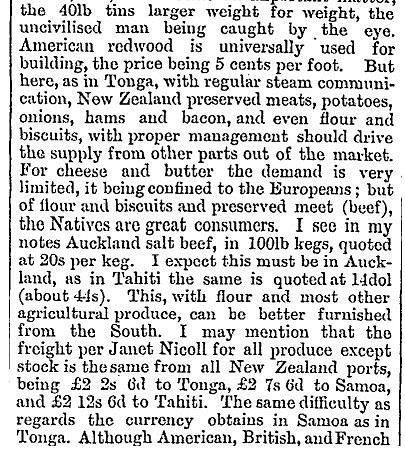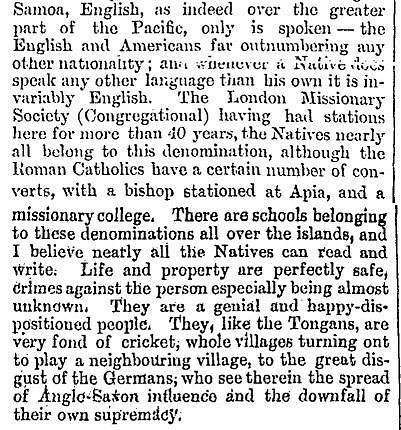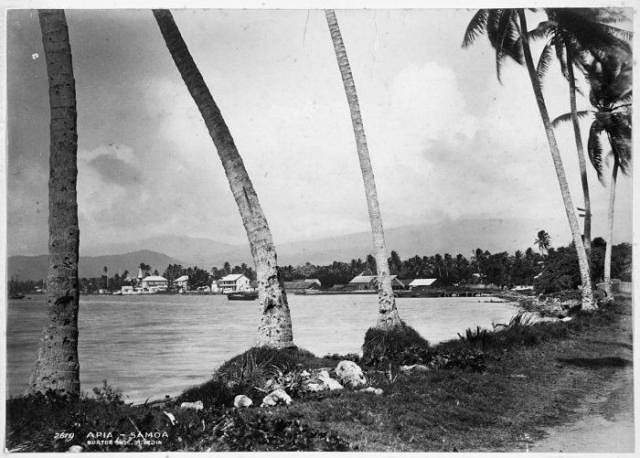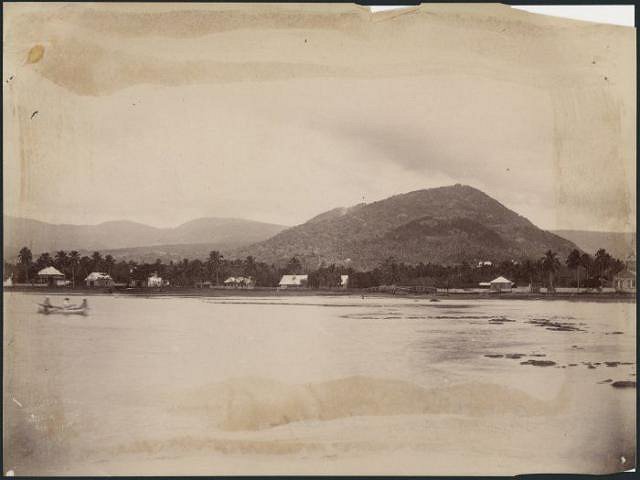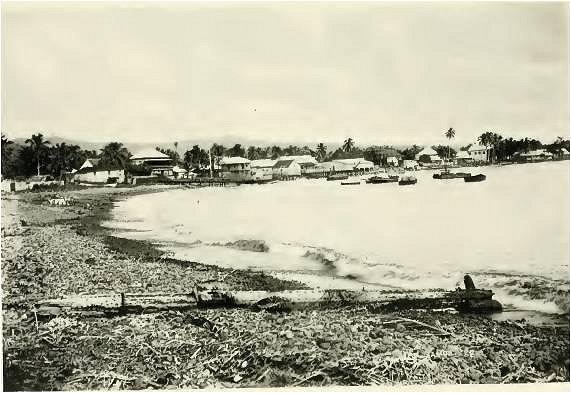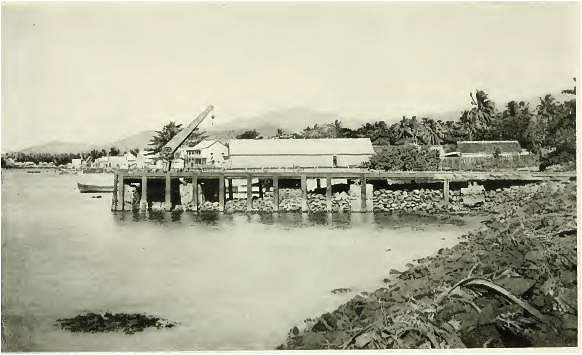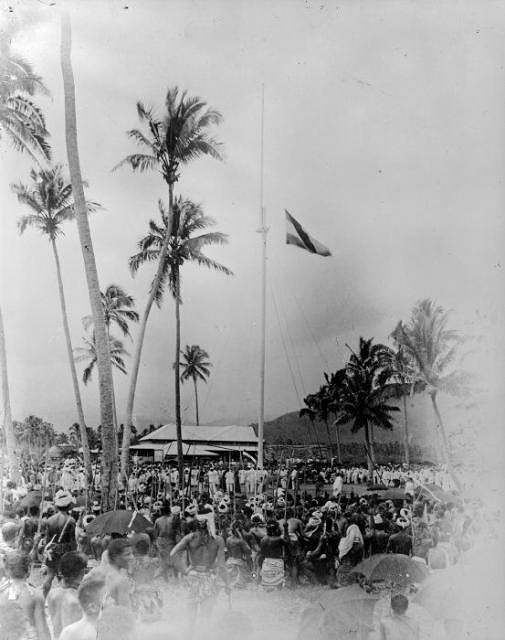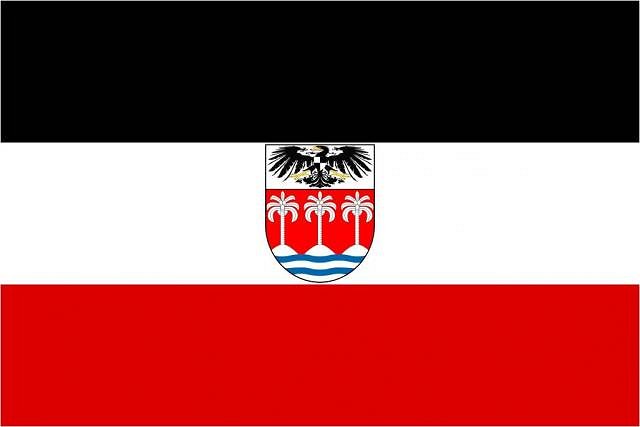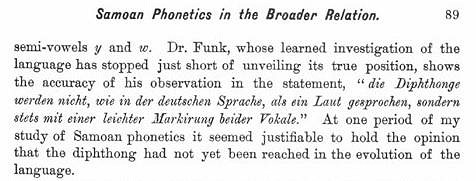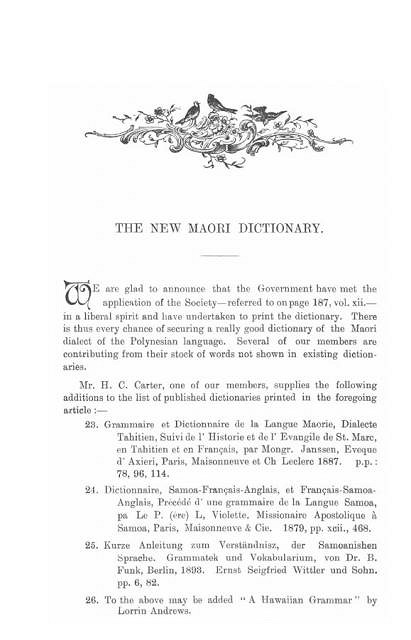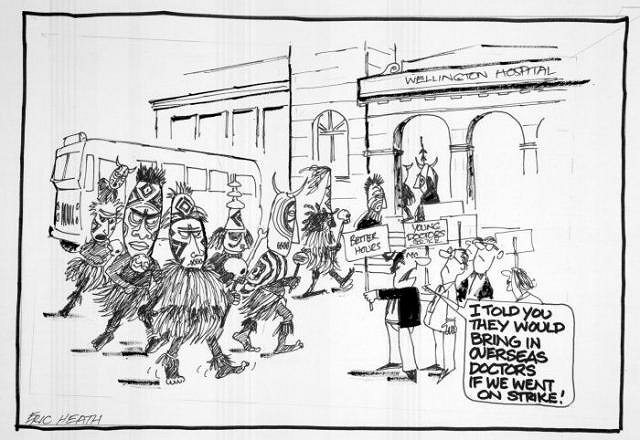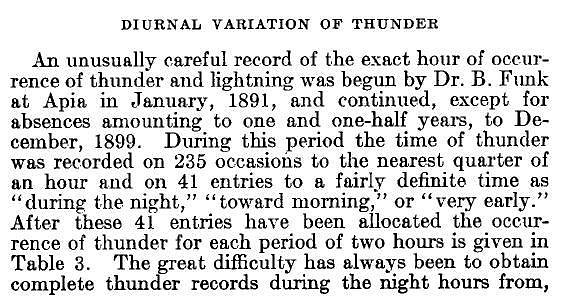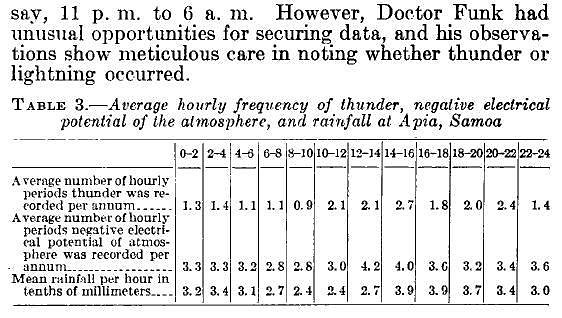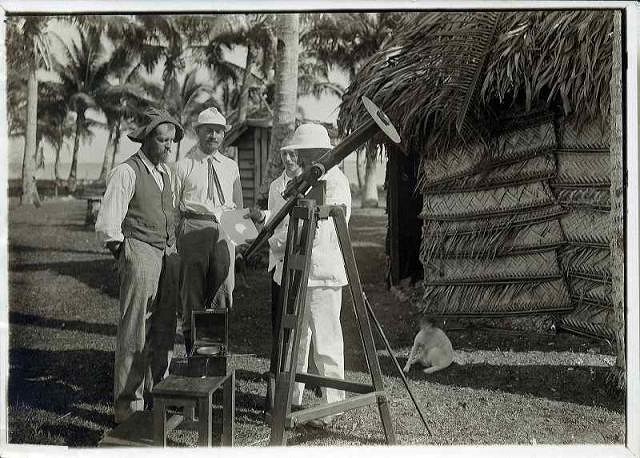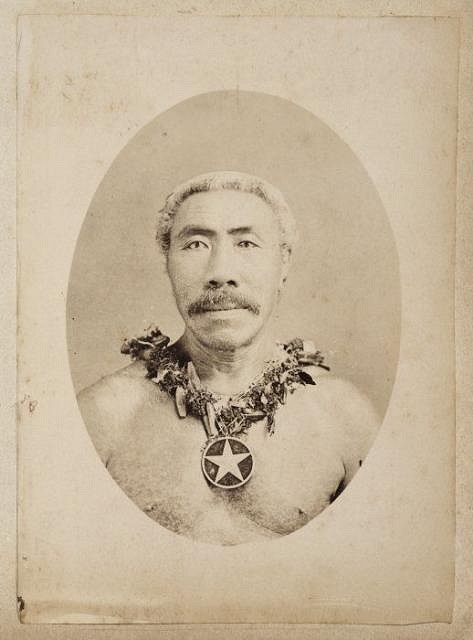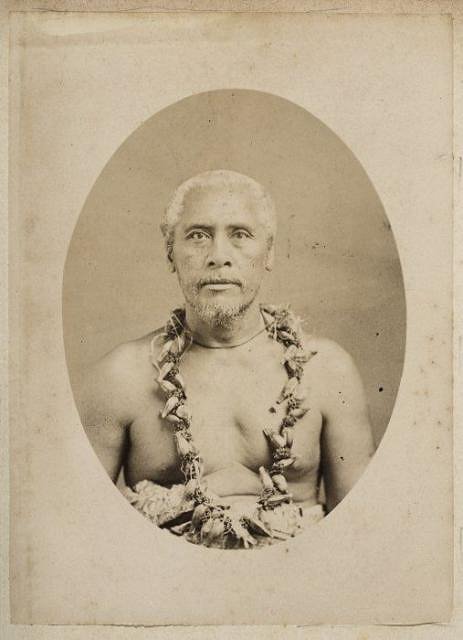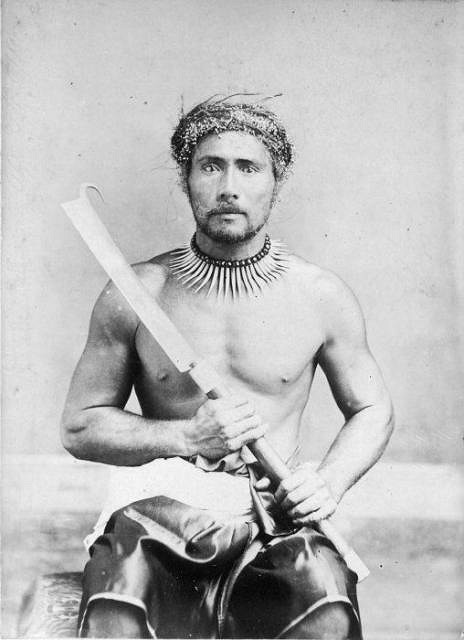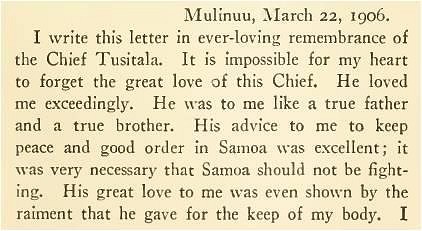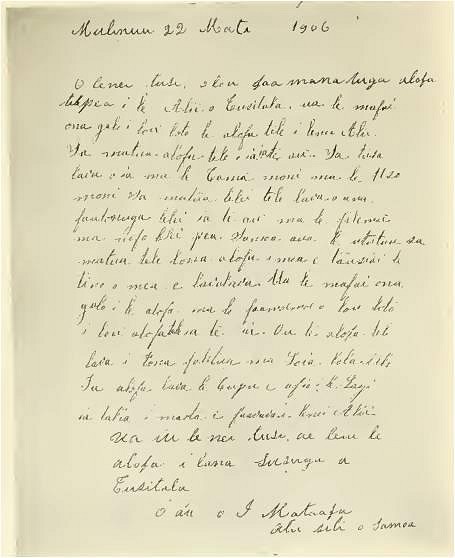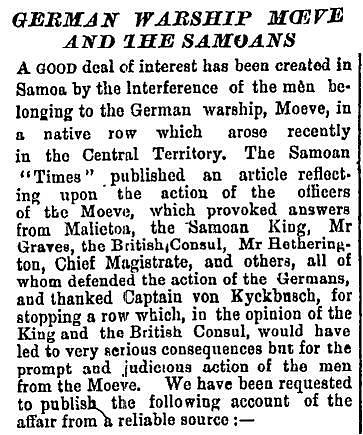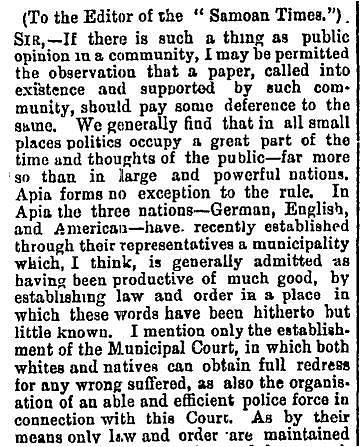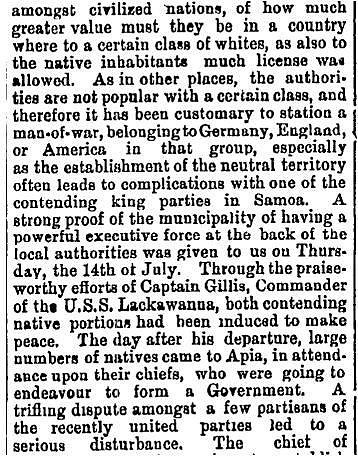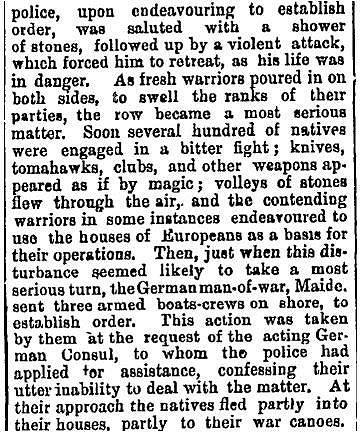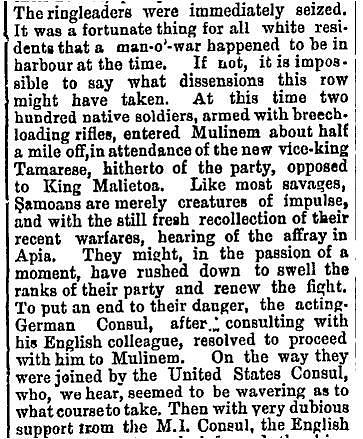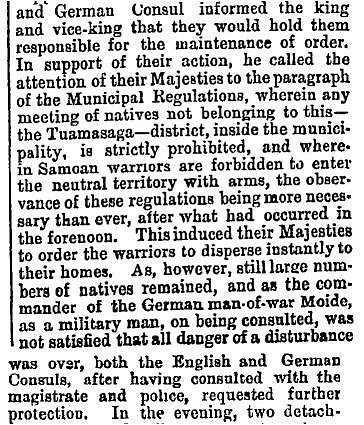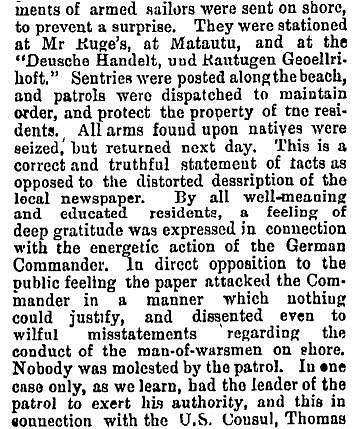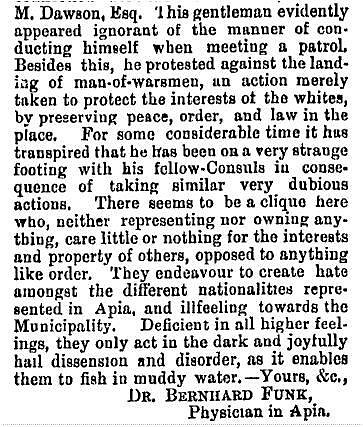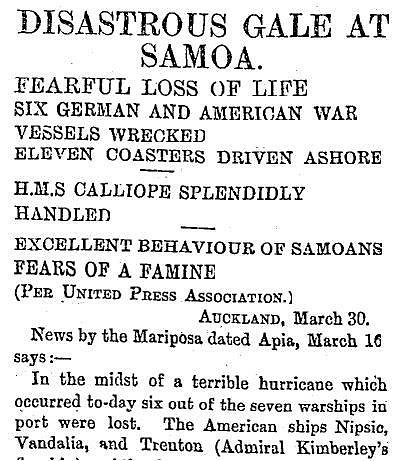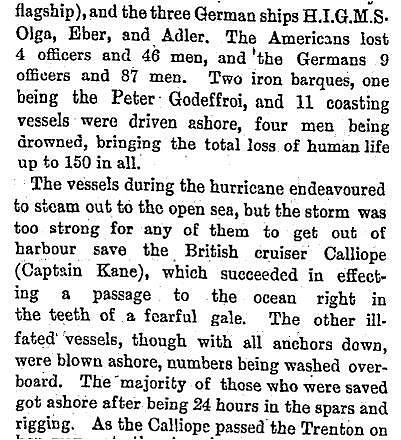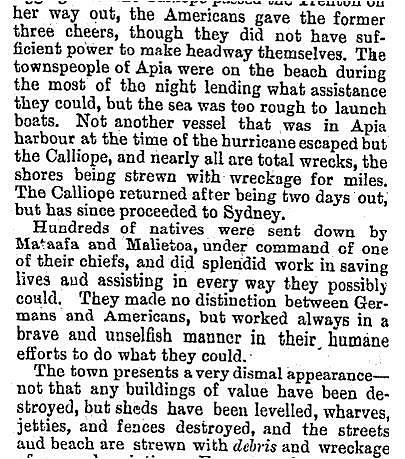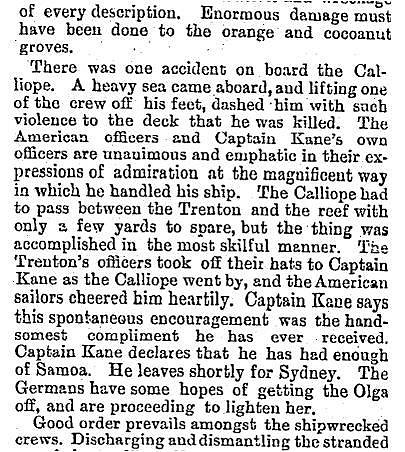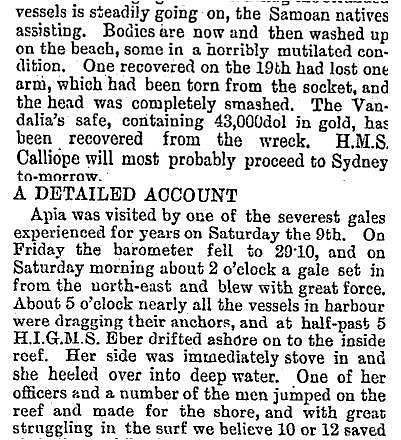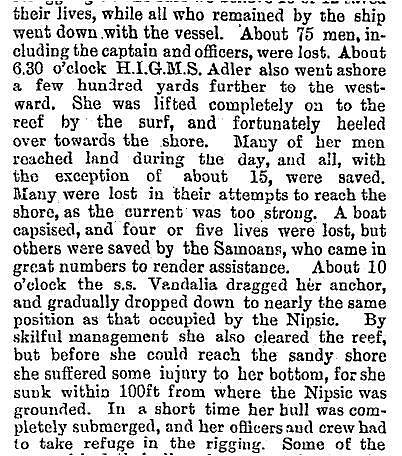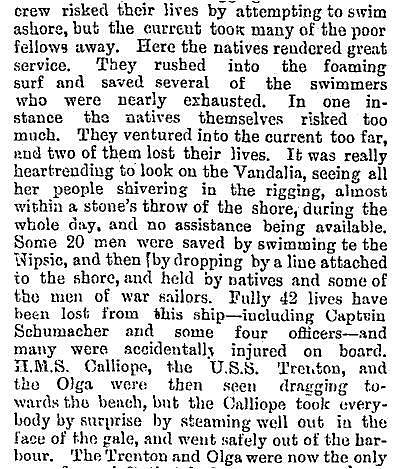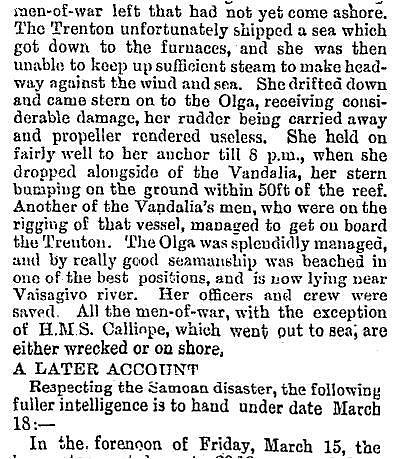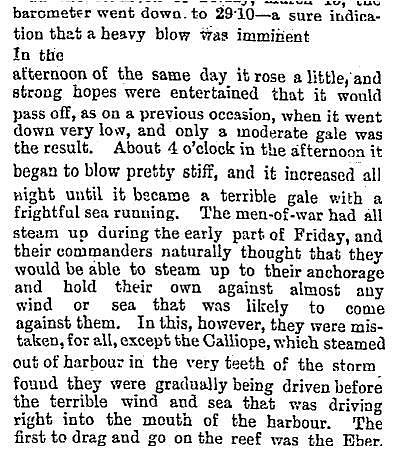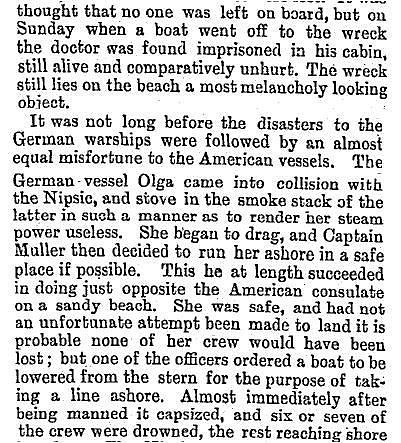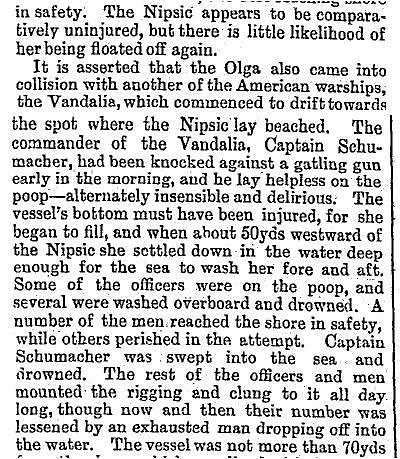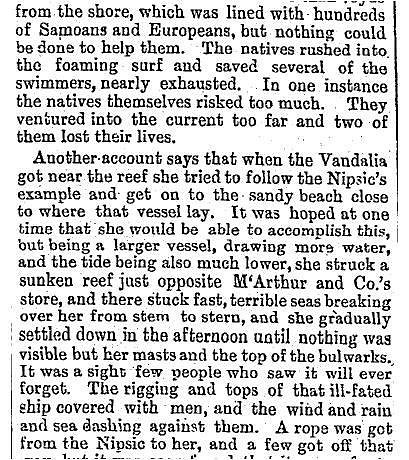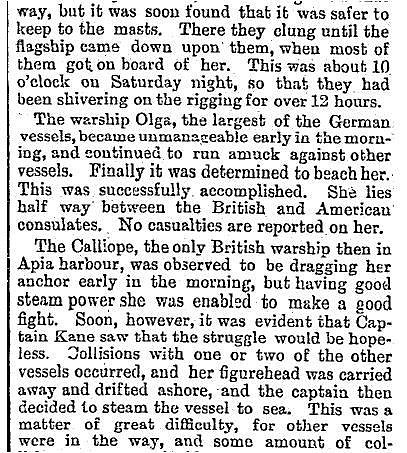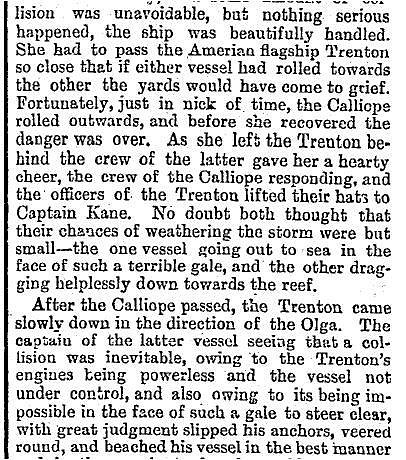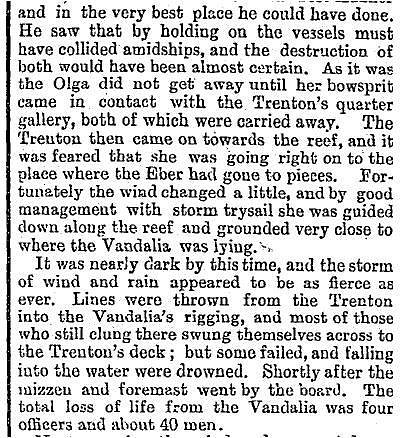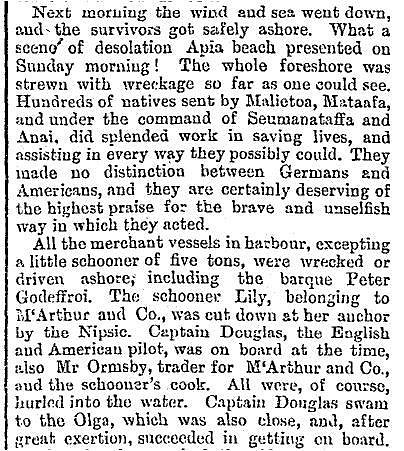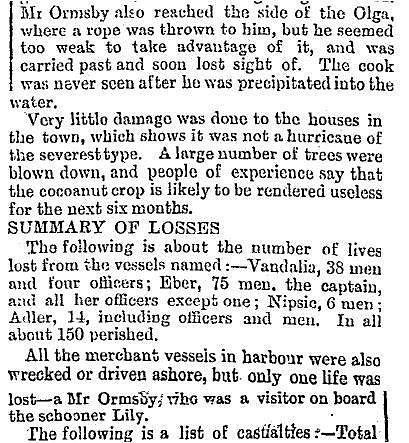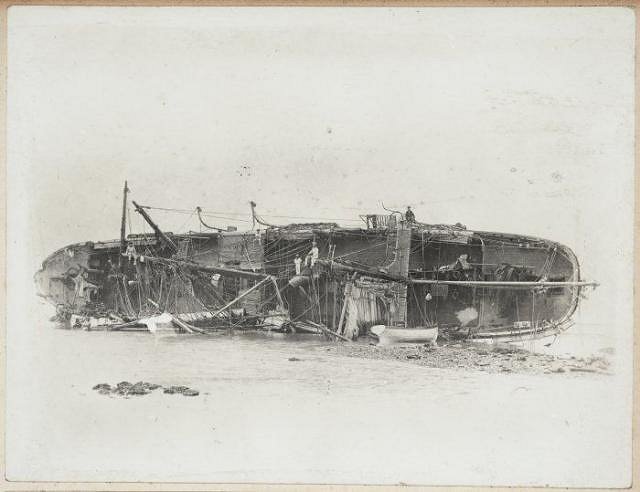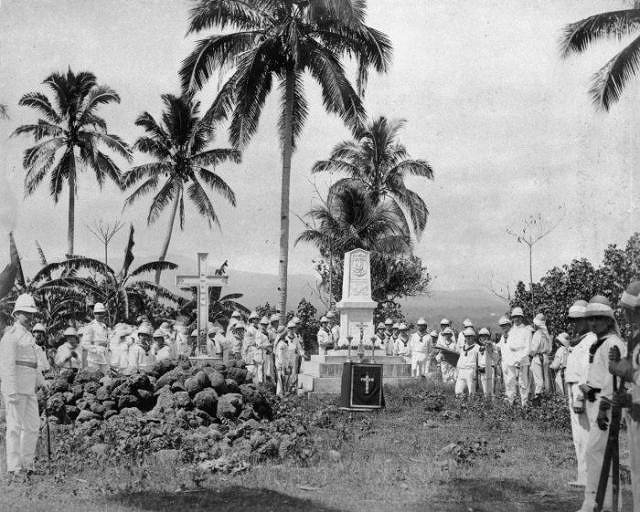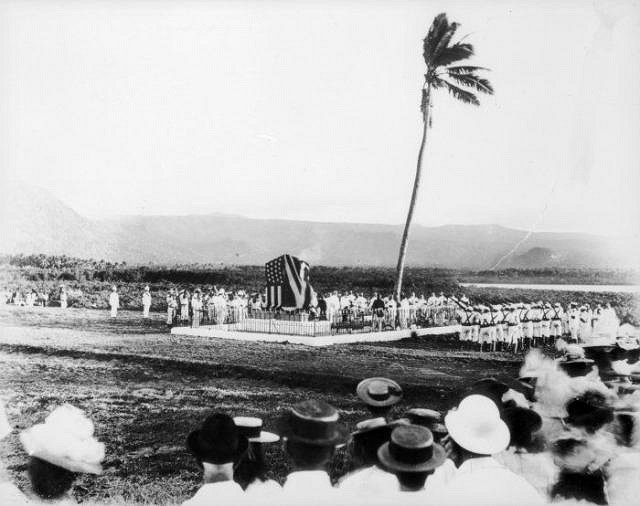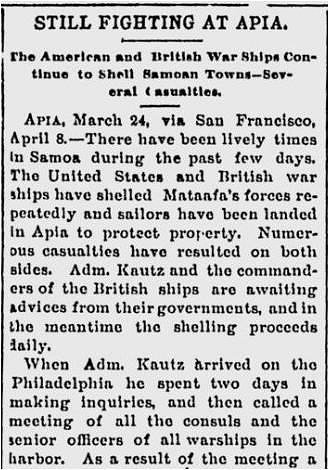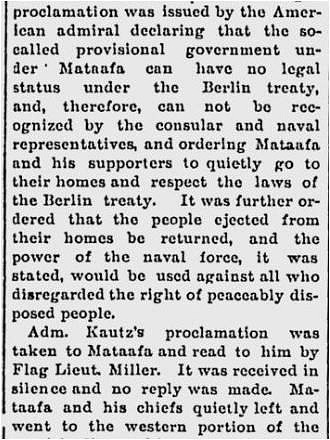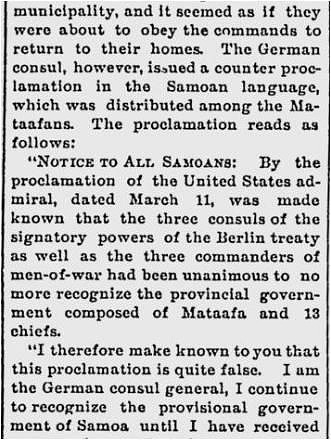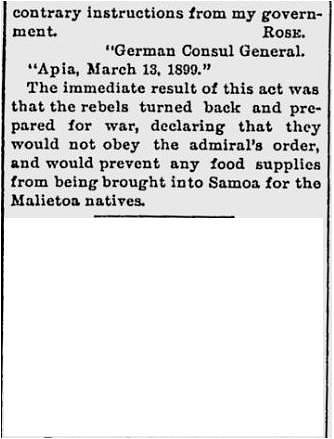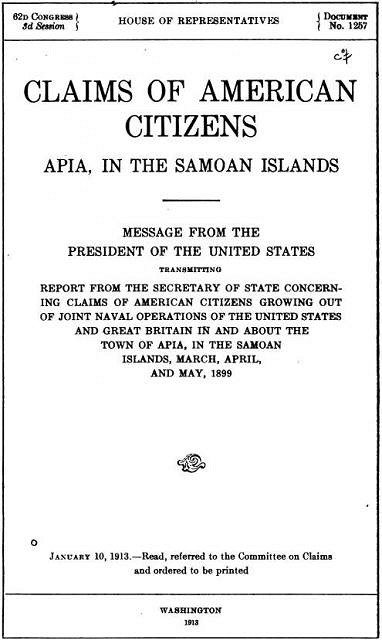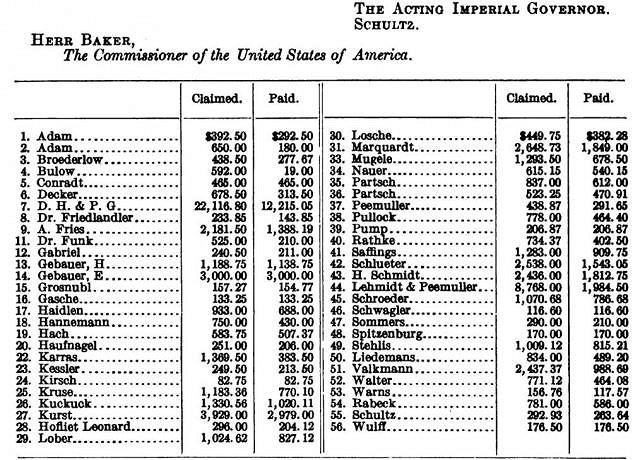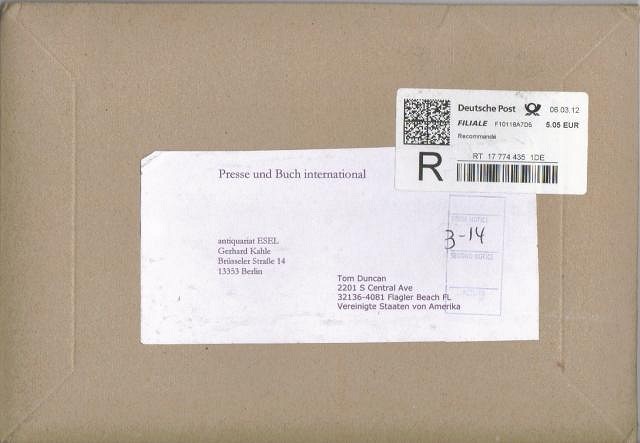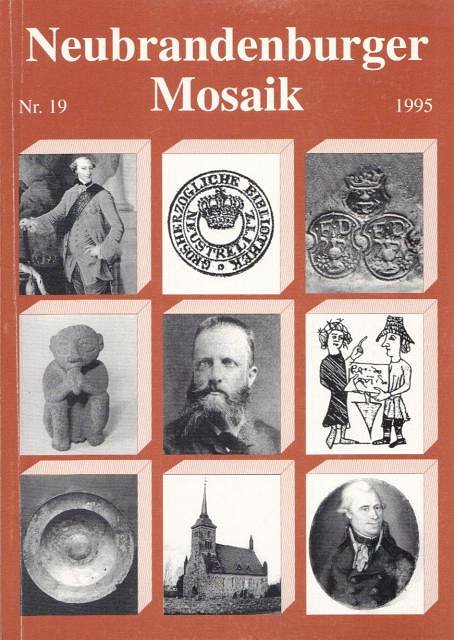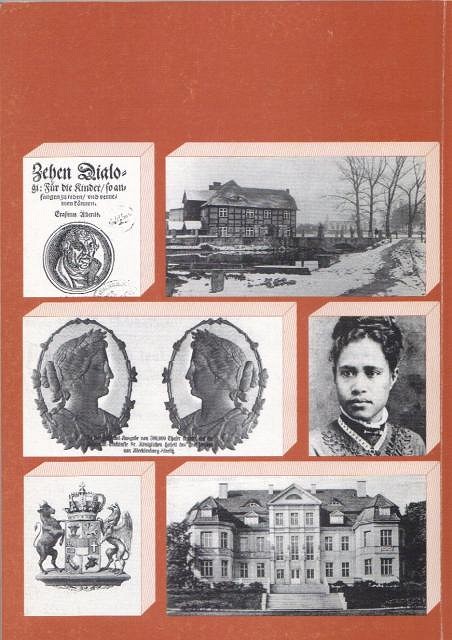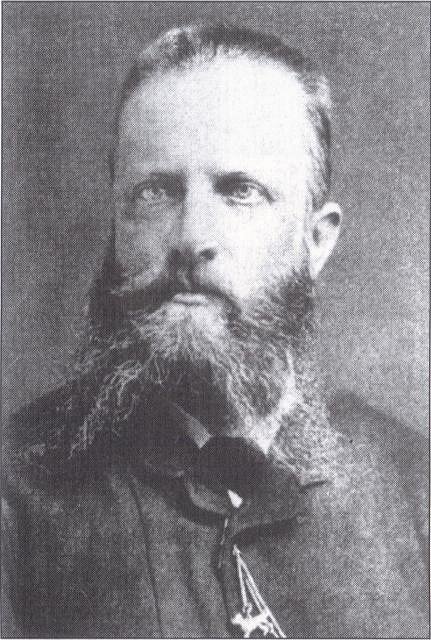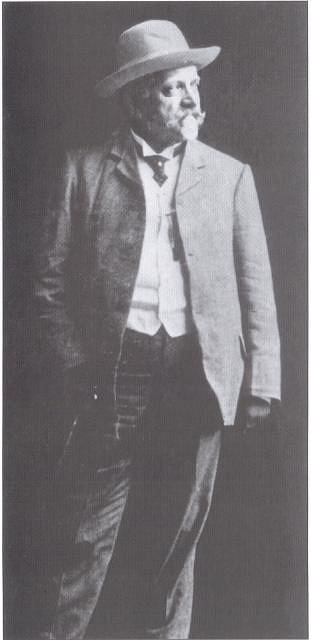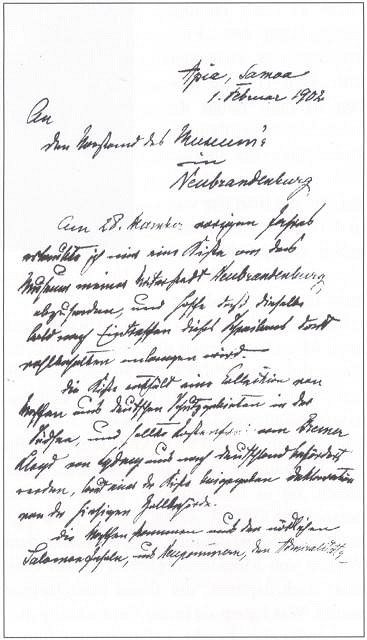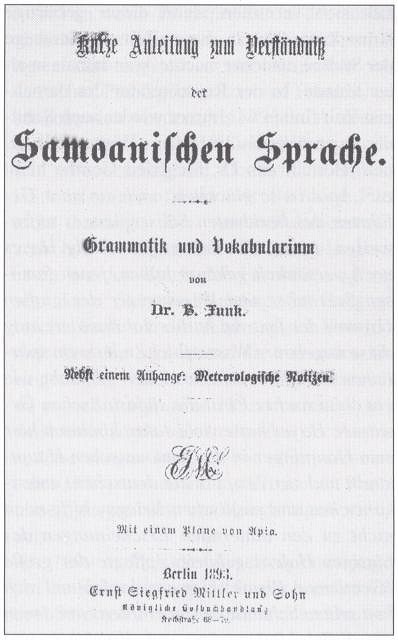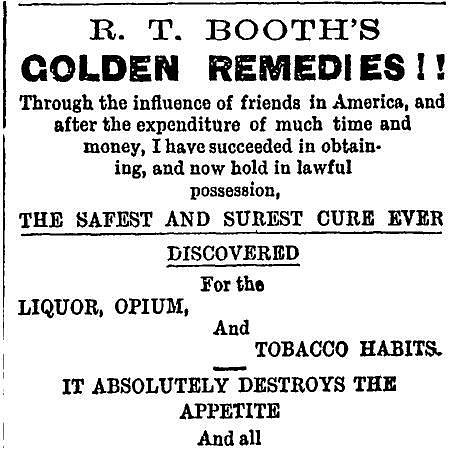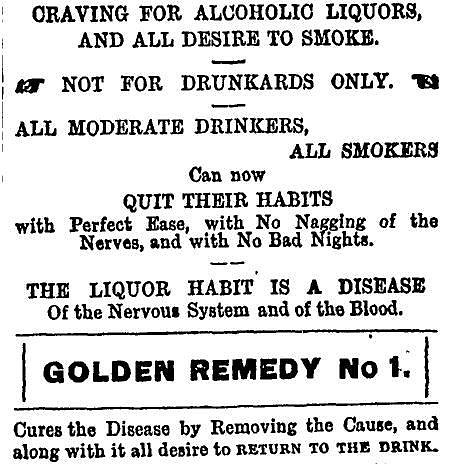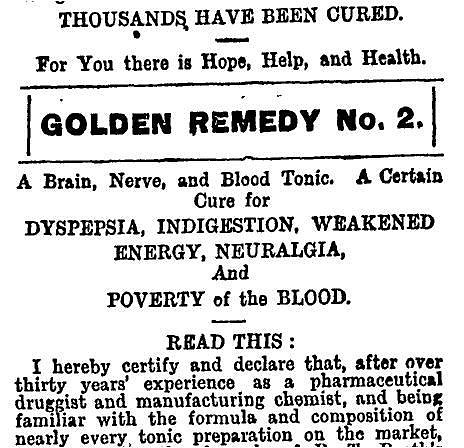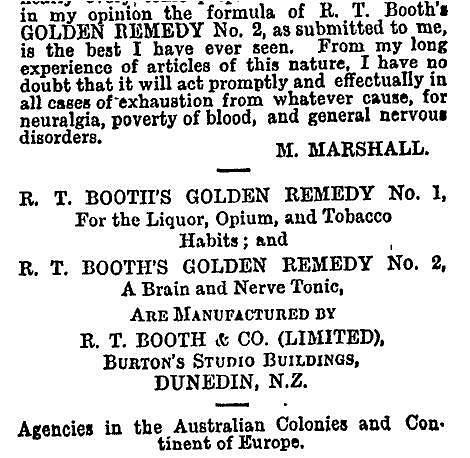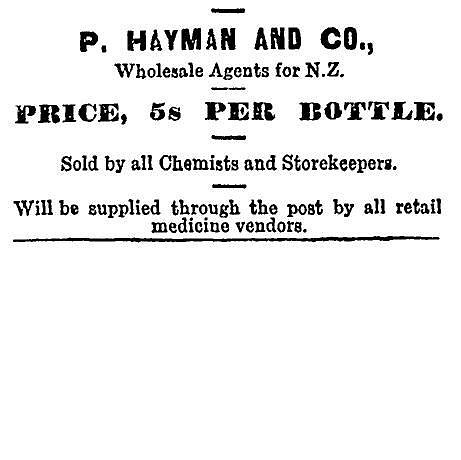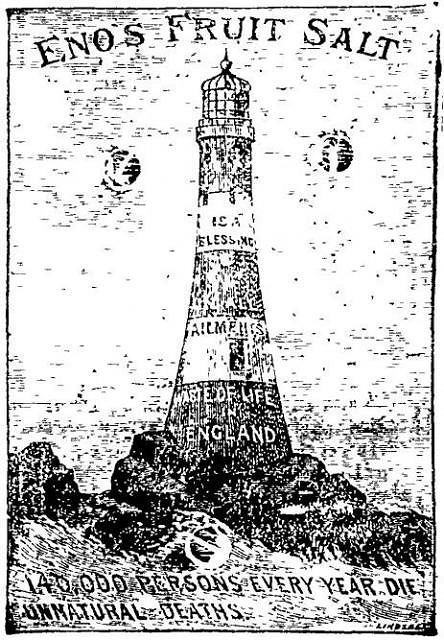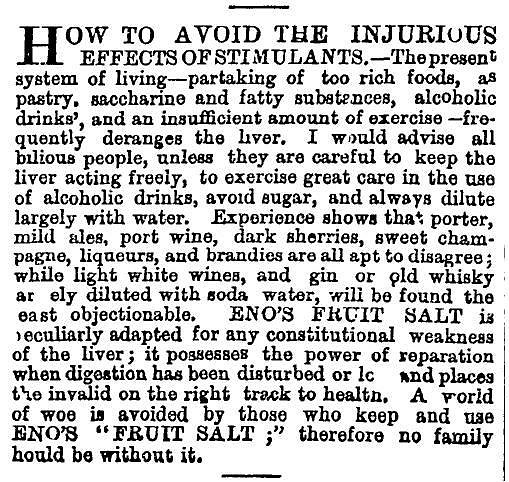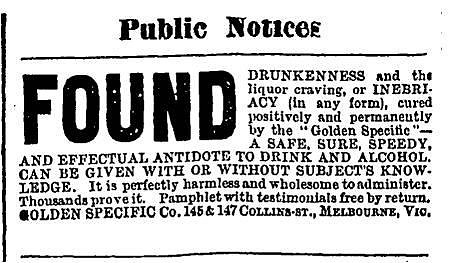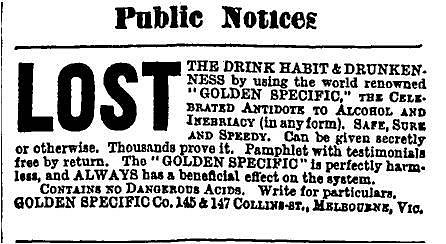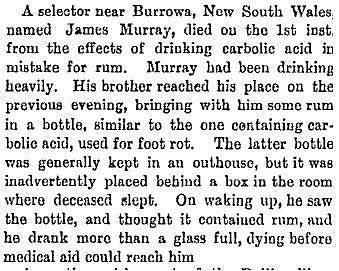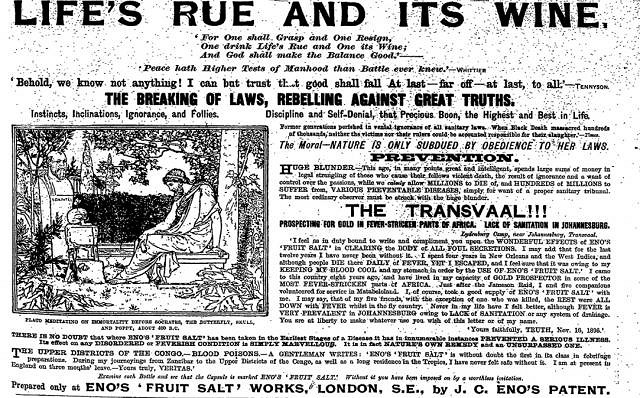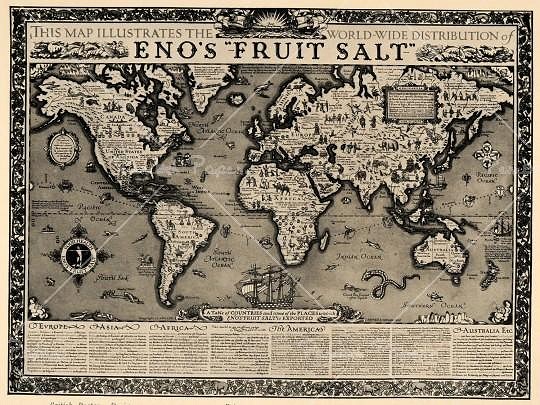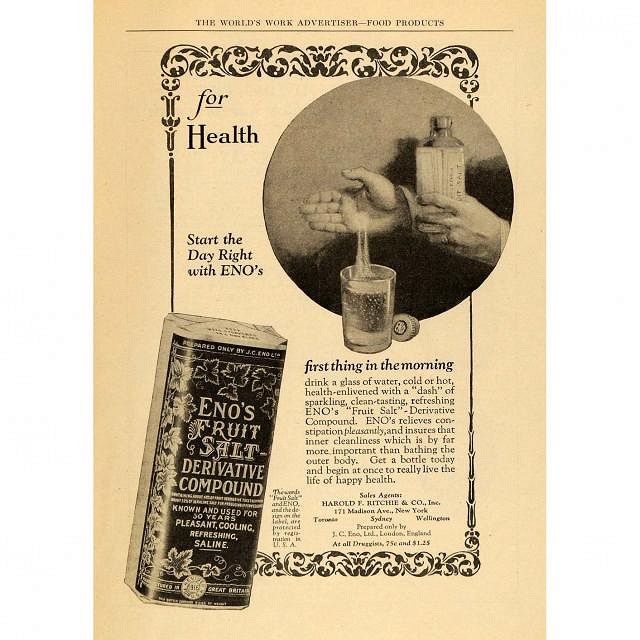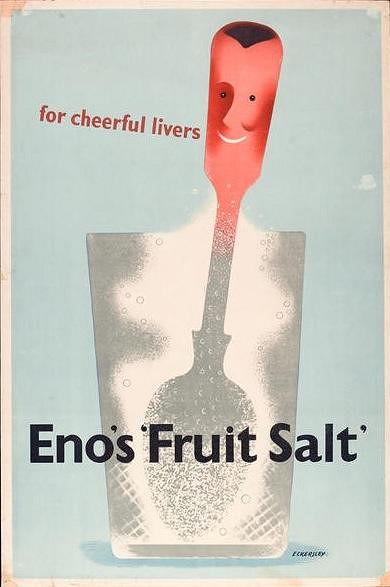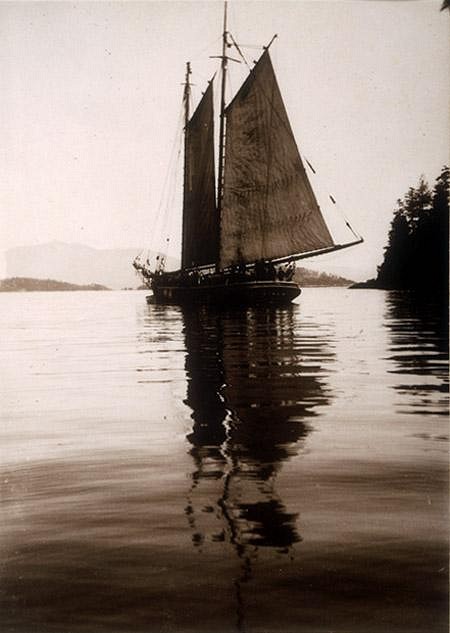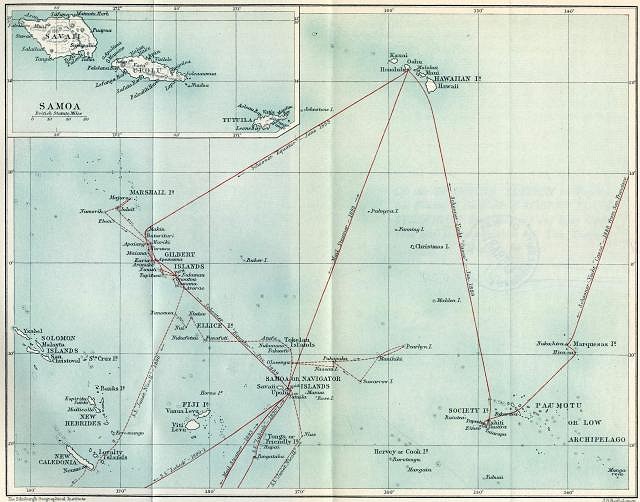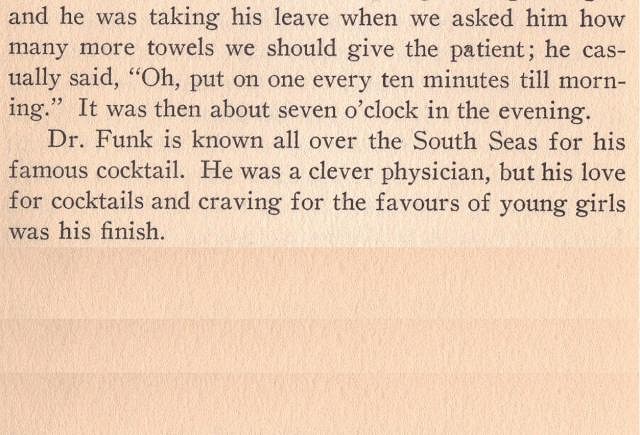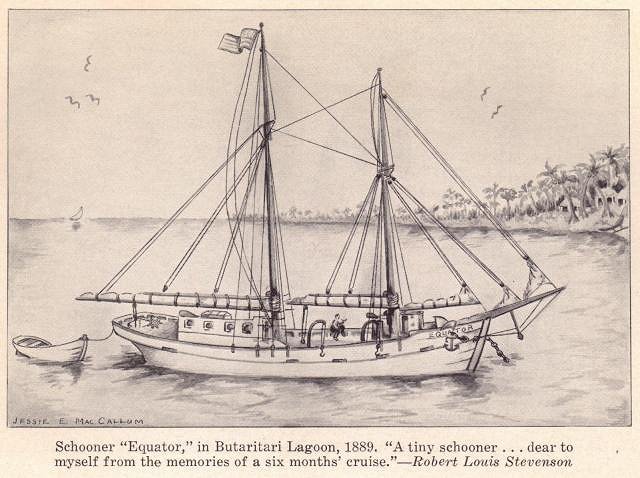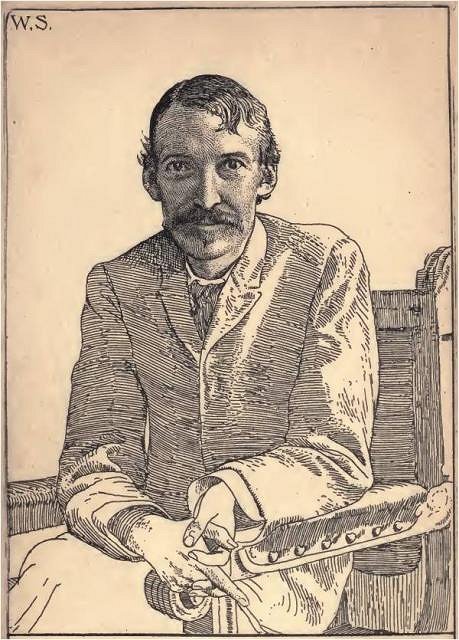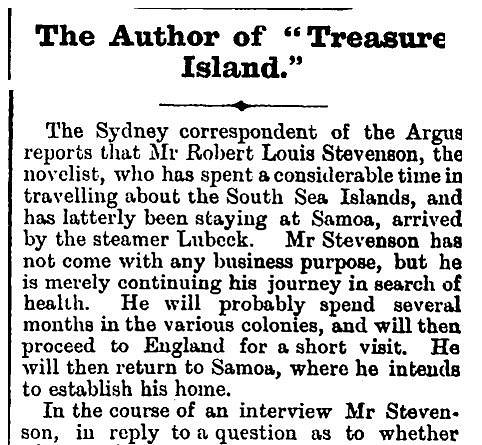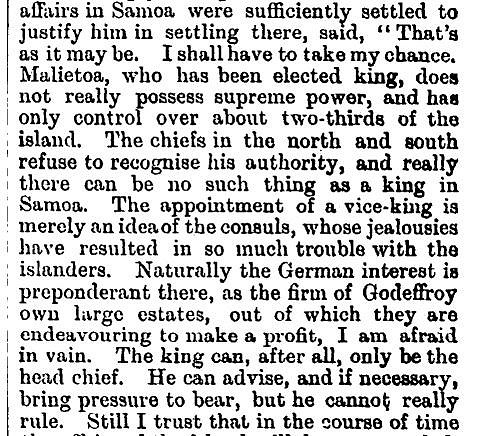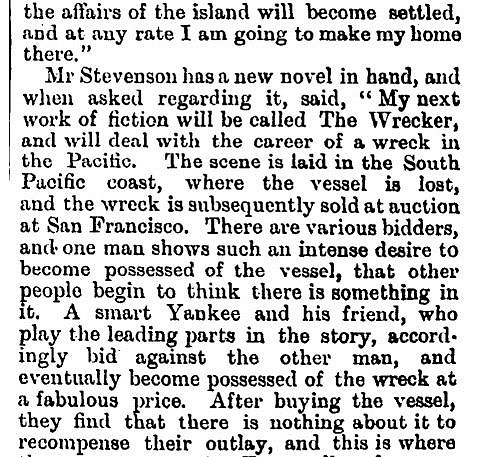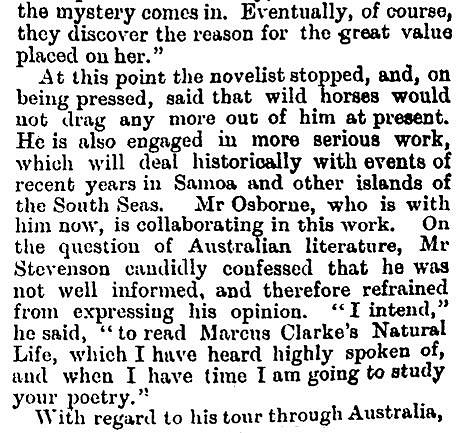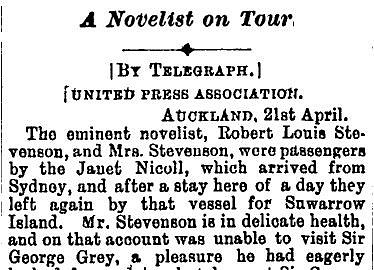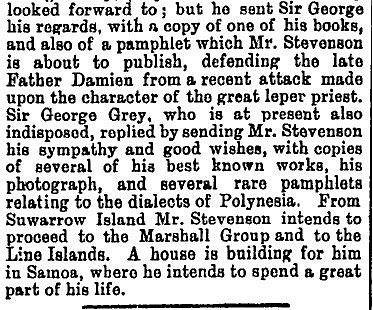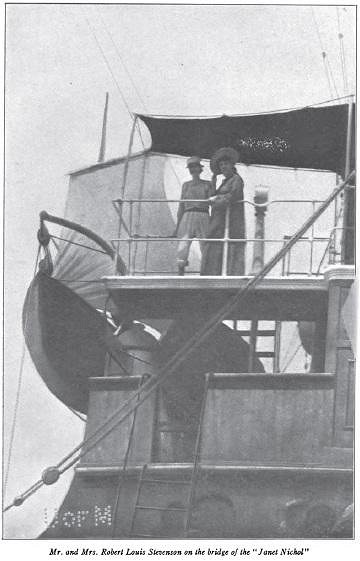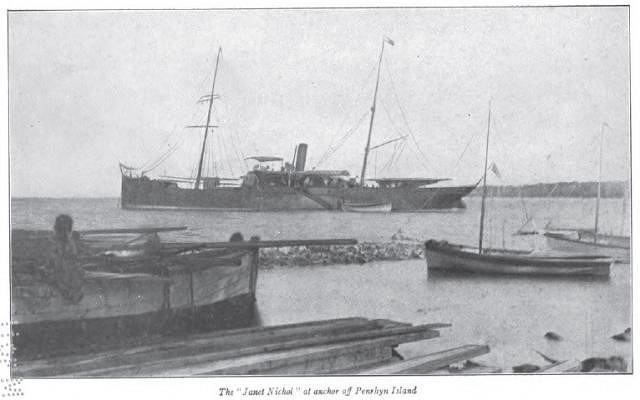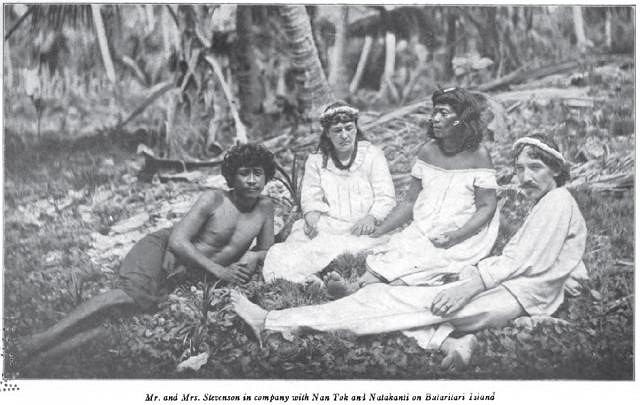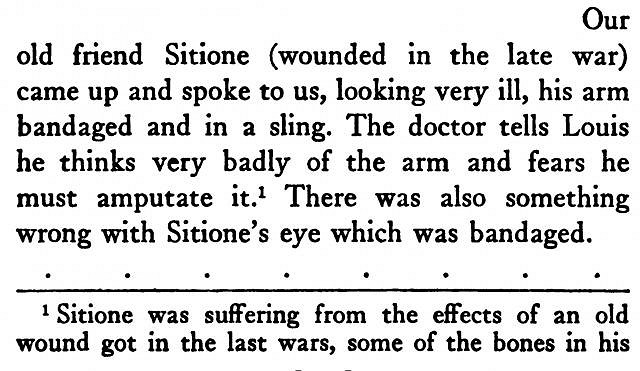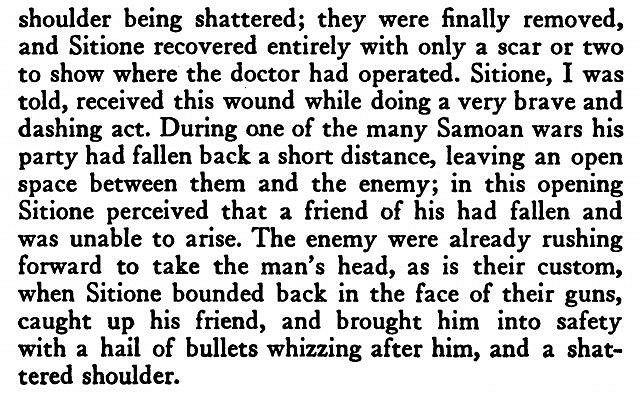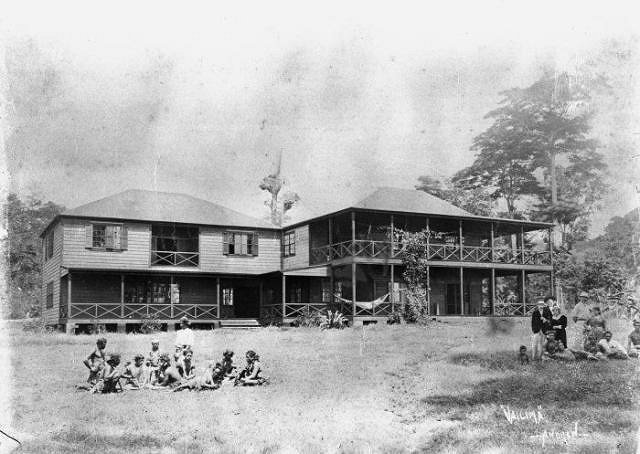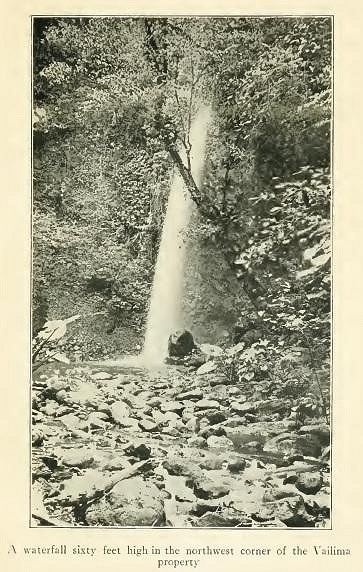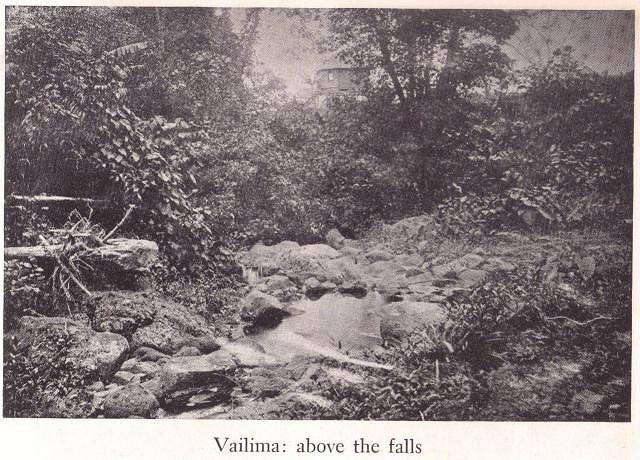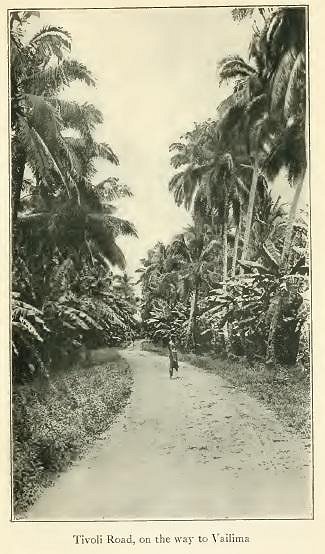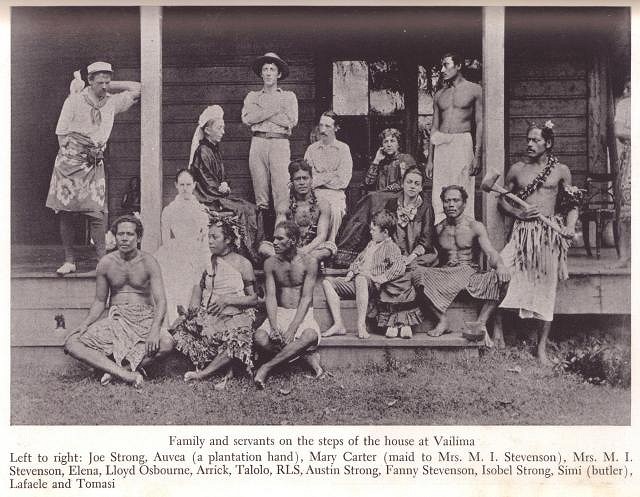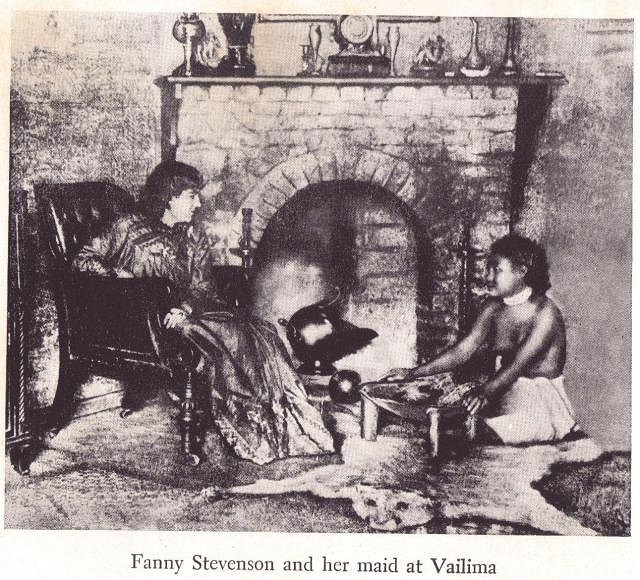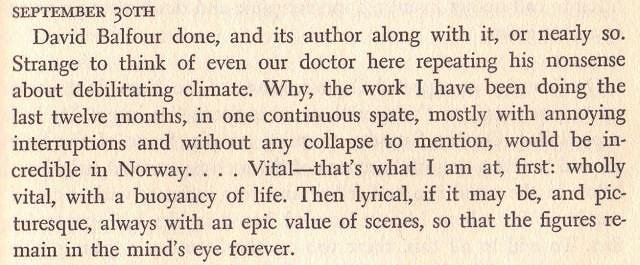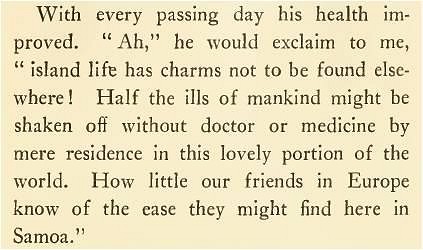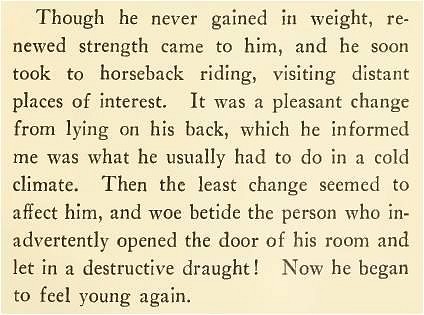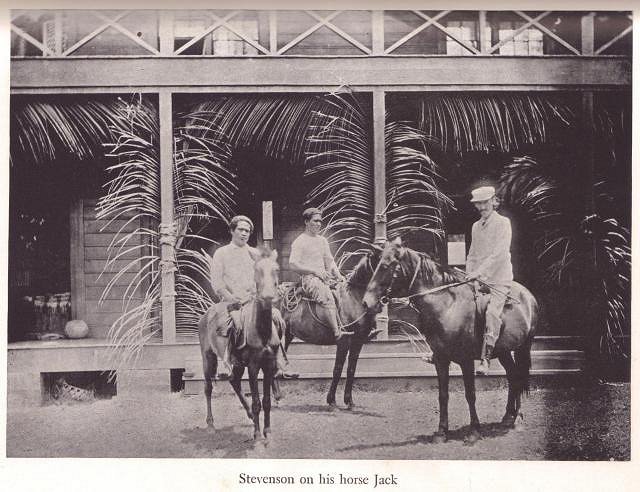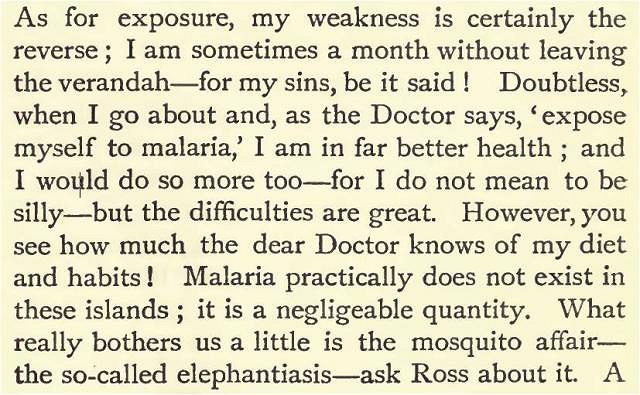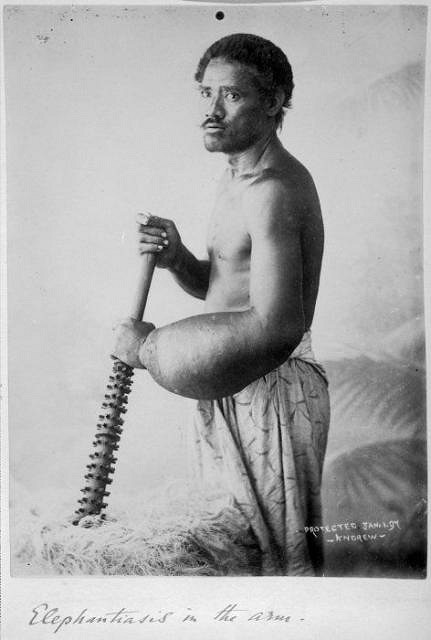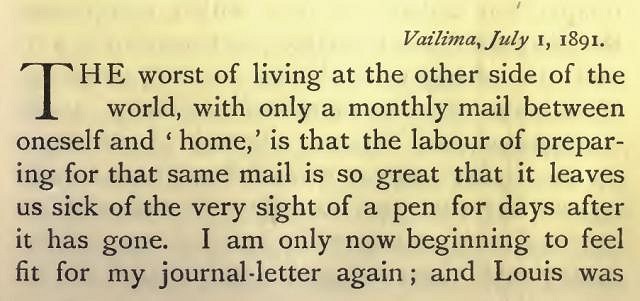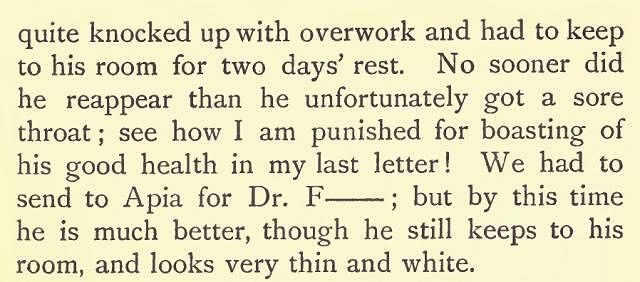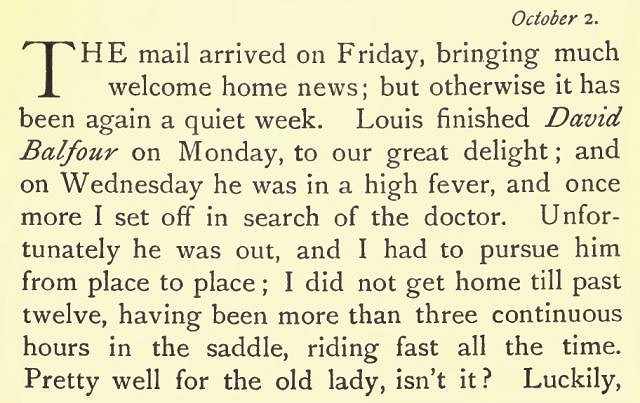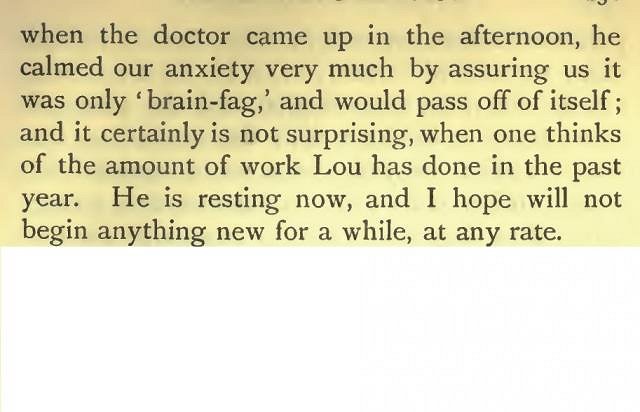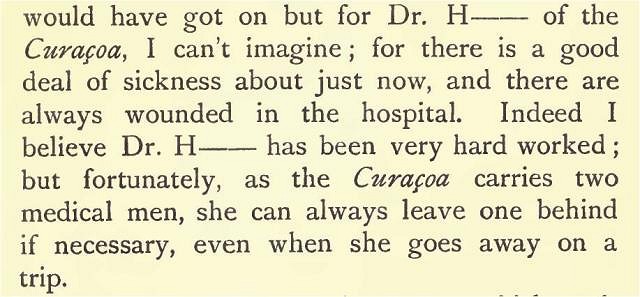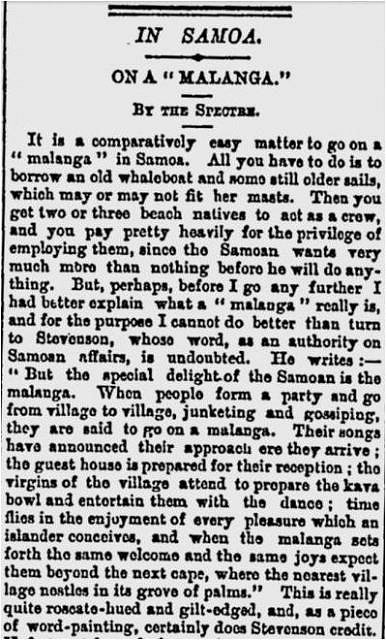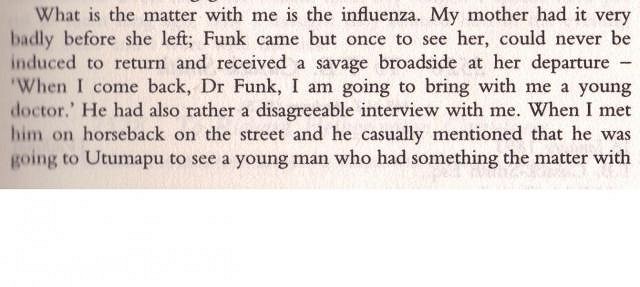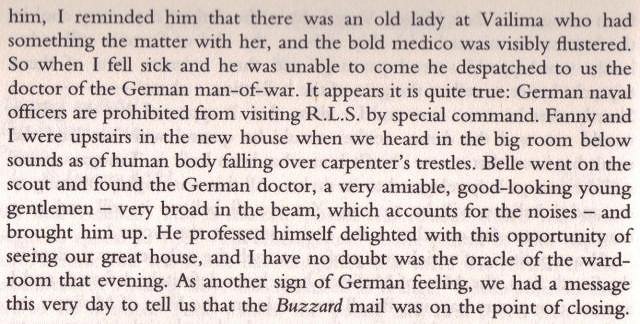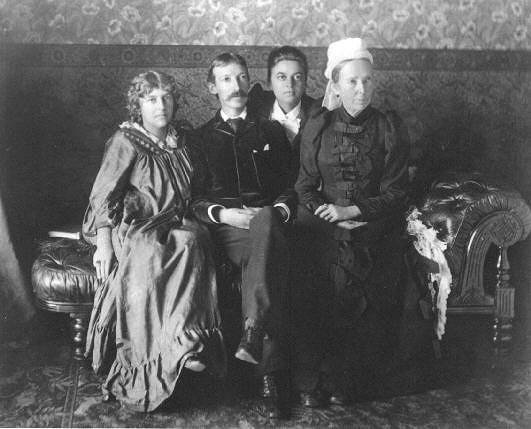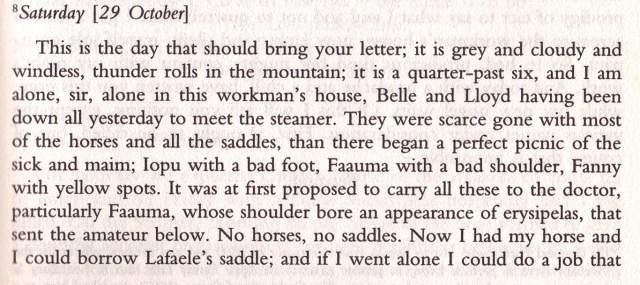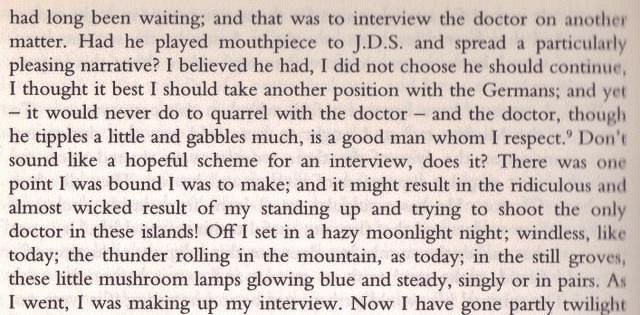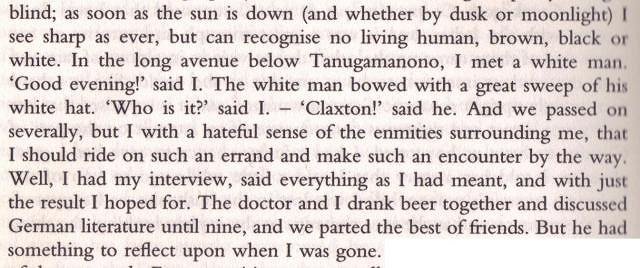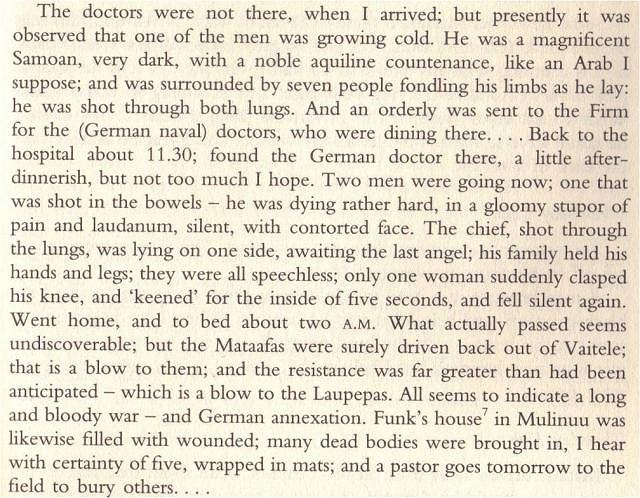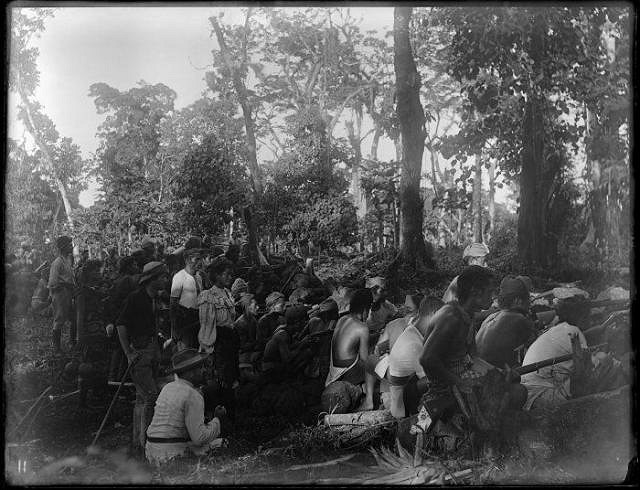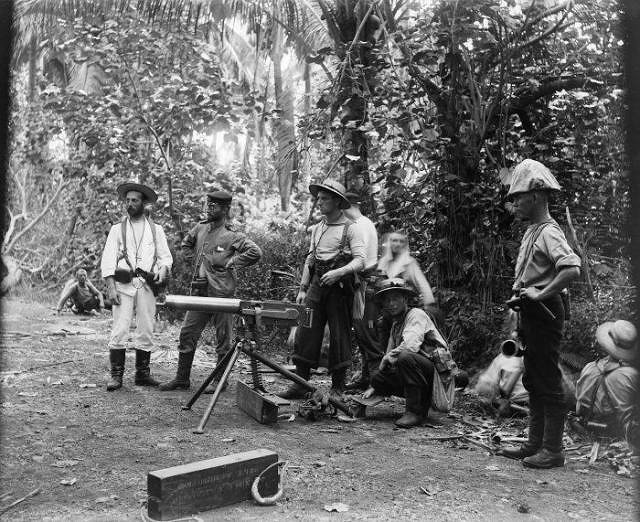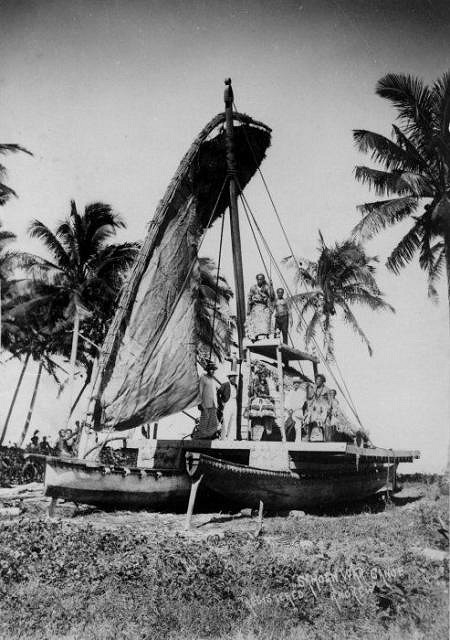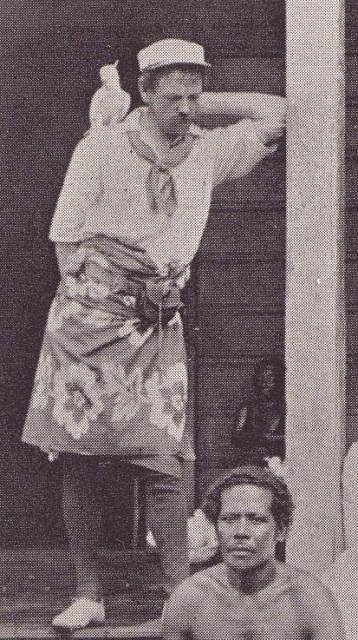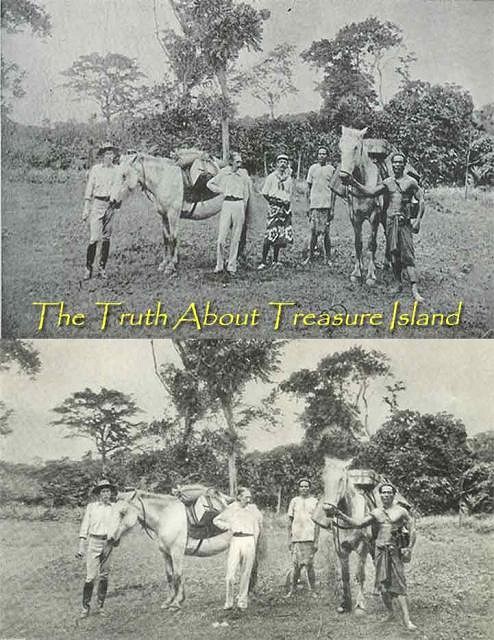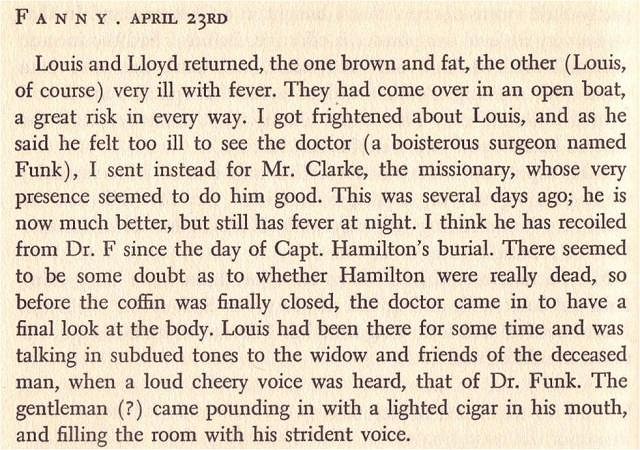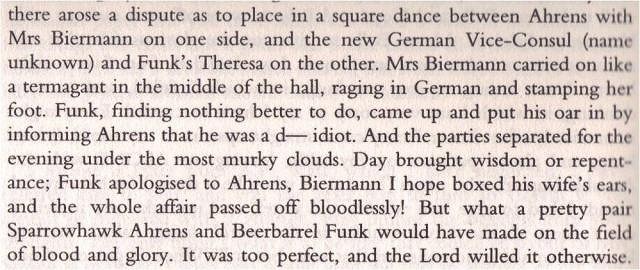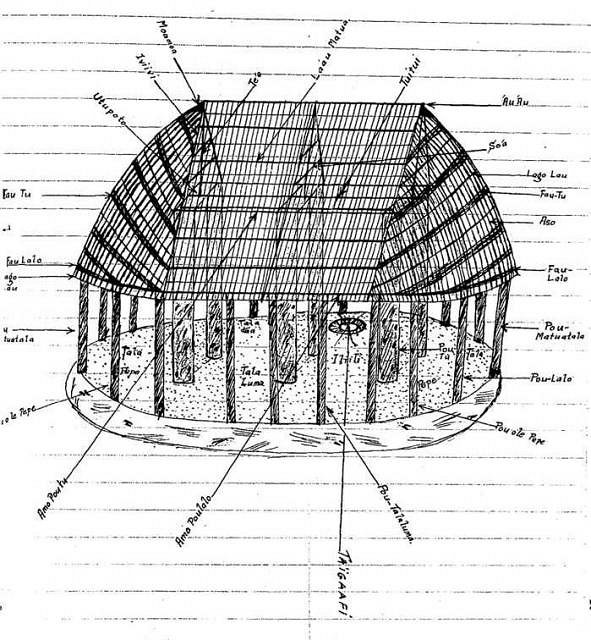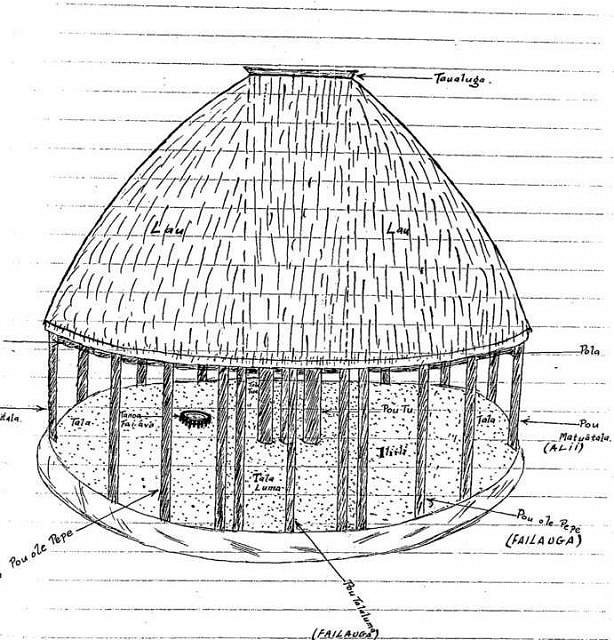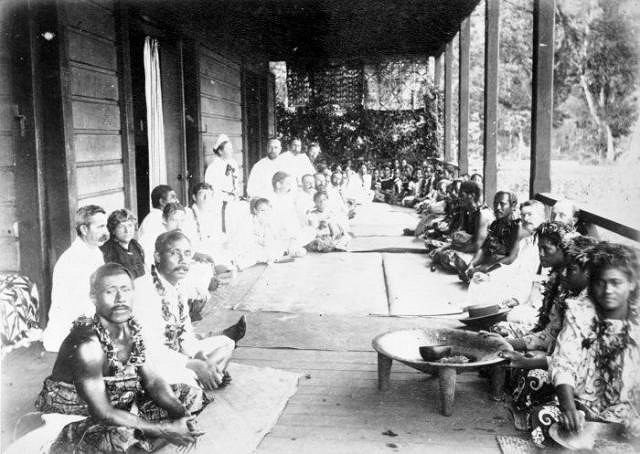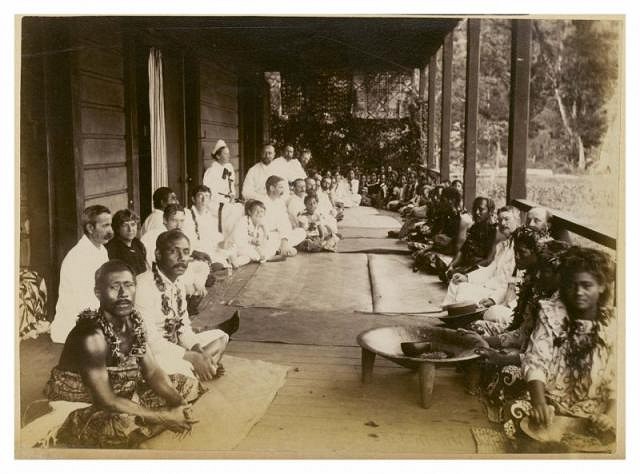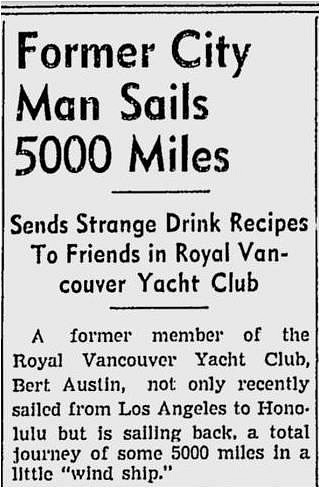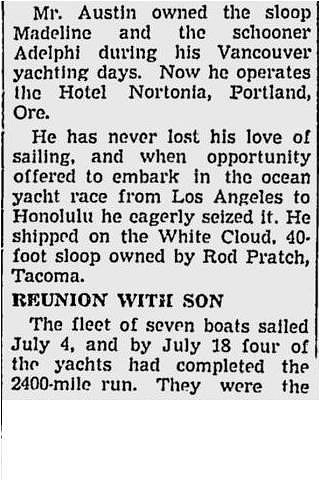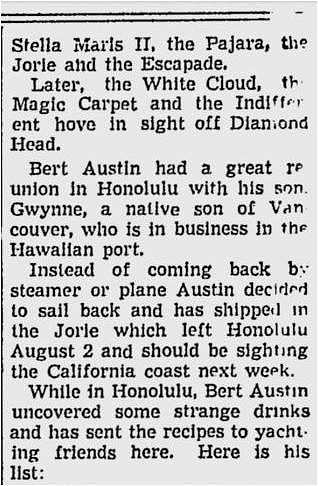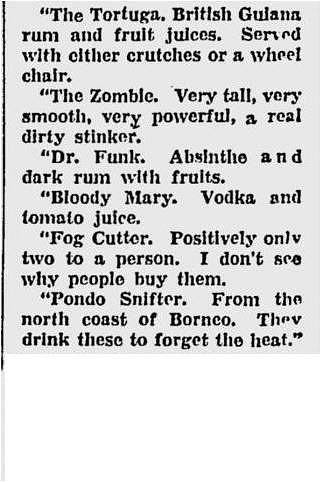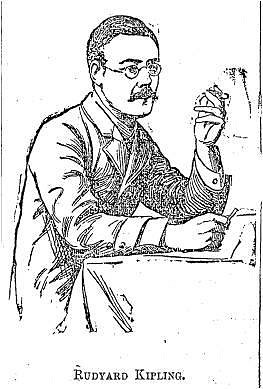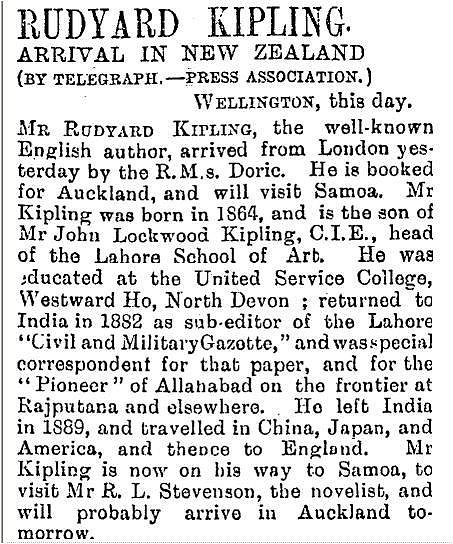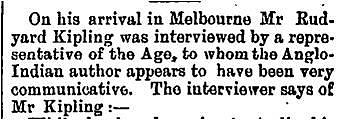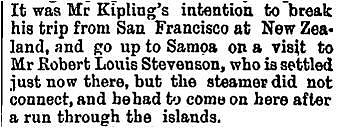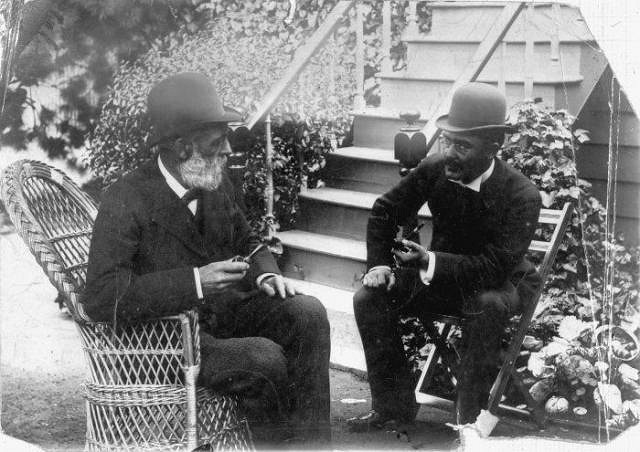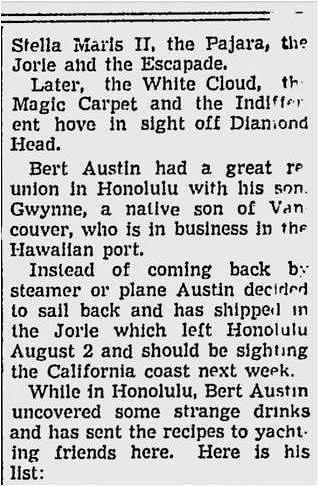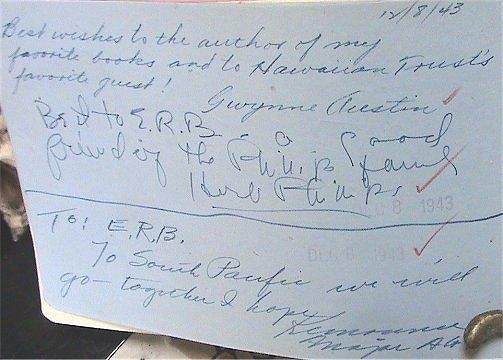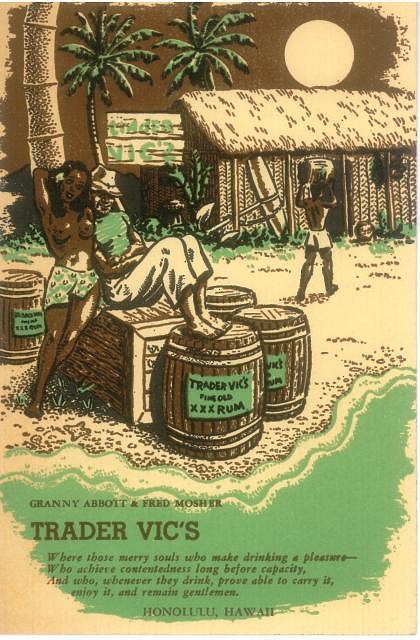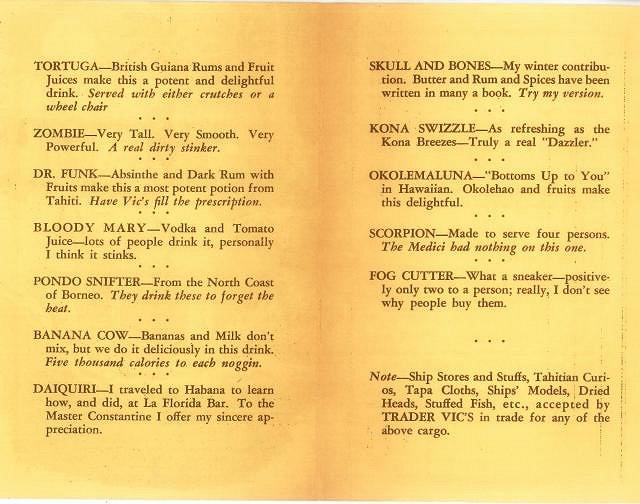Tiki Central / Tiki Drinks and Food
The real Dr. Funk
|
T

TikiTomD
Posted
posted
on
Sun, Feb 26, 2012 8:34 AM
Well said, Porpoise! :) CN, completely agree with you... that photo is going to find a place of honor somewhere proximate to my home Tiki bar. After spending a bit of time reading Leilani Burgoyne’s paper, it’s clear that she did a masterful job reconstructing the life and times of Dr. Funk, assembling a myriad of vignettes from a multitude of sources into a coherent and satisfyingly complete story. I’ll share a few highlights from her paper. Dr. Funk’s initial foray into matrimony occurred within a year of his arrival at Apia, Samoa in 1880. It was a short-lived and disastrous marriage to Leonora Hayes, beautiful fifteen year-old daughter of the infamous American pirate, Captain William Henry “Bully” Hayes. It seems that Dr. Funk’s late father-in-law had been dispatched in 1877 after a violent confrontation with “Dutch Pete” (the ship’s cook) on a voyage from the Marshall Islands to Ascension (Pohnpei) and Strong’s (Kosrae) Islands in the Caroline group. The widowed New Zealand-born Emily Hayes and her two teenage daughters remained in Apia, the little “Cairo of the Pacific,” at the time of Dr. Funk’s arrival. The marriage ended within six months in a publically humiliating way for Funk, as his wife sought divorce on grounds of cruelty, alleging that he had beaten her. Burgoyne’s research suggests that Dr. Funk was likely the victim of a scheme to fleece the presumably rich newly-arrived German doctor by an unscrupulous family in dire financial straits. When Leonora left Funk, she took with her their infant son, Conrad Funk. The son was apparently known around Apia as Fred Hayes. Dr. Funk provided for the expenses of his child, and archival records indicate that his son took the old doctor in years later when he fell ill. Bully Hayes, notorious South Seas pirate and blackbirder (slave trader), was born in Cleveland, Ohio. Jane Resture’s Oceania web site has a wealth of information on the subject. From her web site comes the only known photograph of Dr. Funk’s former father-in-law...
Hayes named one of his ships the Leonora, after his favorite daughter. Here’s a William McDowell painting of it, also from Jane Resture’s web site...
An Australian, Louis Becke, delivered a ketch to Bully Hayes and rode as a passenger on the Leonora. A colorful character in his own right, he later wrote about Hayes...
One of his stories, “Concerning ‘Bully’ Hayes,” excerpted from The Strange Adventure Of James Shervinton and Other Stories (1902) can be freely accessed online as a Project Gutenberg eBook. Here Becke introduces Hayes (caution to the reader: remember that Becke’s words reflect the colonial usage of the times and that Hayes was engaged in the slave trade)...
It’s kind of curious that the Federated States of Micronesia issued postal stamps in 1986 depicting various events surrounding Hayes...
-Tom |
|
LL

Limbo Lizard
Posted
posted
on
Mon, Feb 27, 2012 12:52 PM
In Michener's book, Rascals in Paradise, Chapter 7 is Bully Hayes, South Sea Buccaneer. I expect many of us have it in our home library. |
|
T

TikiTomD
Posted
posted
on
Wed, Feb 29, 2012 3:13 PM
Limbo Lizard, Rascals in Paradise is one Michener book that I don’t have on my bookshelf, but probably should. I don’t recall seeing this, but there was a 1983 movie, Nate and Hayes, loosely based on the life of Bully Hayes, starring Tommy Lee Jones as Hayes. It is apparently available on DVD...
There’s even a Bully Hayes Restaurant & Bar, located in Akaroa, New Zealand...
Here are a couple of 19th century newspaper articles from the National Library of New Zealand archives that report the demise of Bully Hayes. The second one mentions the wife and children living on Samoa, later encountered by Dr. Funk, much to his detriment... Taranaki Herald October 8, 1877 Evening Post October 27, 1877 Here’s one more article that is insightful on the character of Hayes, and also presaged the movie to come more than three quarters of a century later... Southland Times August 25, 1903 -Tom |
|
B
bigbrotiki
Posted
posted
on
Wed, Feb 29, 2012 7:19 PM
I say, some people lived the life of movies - before there were any. I come late to this party in congratulating you to this find, Tom. I was busy on the desert island of Palm Springs, fishing for other prey:
I am looking forward to further posts about the Dr. Funk find. And I just now found your findings ( :) ) about Augustin Kraemer! What was it with all these Germans being into Pacific ethnography! It appears he did for Samoa what Karl von den Steinen did for the culture of the Marquesas Islands: http://www.tikicentral.com/viewtopic.php?topic=31804&forum=1&vpost=443195 [ Edited by: bigbrotiki 2012-02-29 23:31 ] |
|
T

TikiTomD
Posted
posted
on
Thu, Mar 1, 2012 10:40 AM
Sven, I followed the Palm Springs Modernism Week thread with great interest... it’s events like that that make me wish Florida and California weren’t so far apart. Looking forward to seeing you soon at Hukilau in Fort Lauderdale. In that second photo, who’s the predator and who’s the prey? Beautiful shot! There’s definitely more to share on Dr. Funk, and I look forward to posting as time permits. One thing that’s readily apparent from this research: the 19th and early 20th centuries were fascinating times in Oceania with an oft-times incendiary intersection of colonial powers and interests in competition and conflict with each other and with indigenous populations. I’m confounded by the many connections among historic characters, events and places, considering the large distances and correspondingly great times of transit involved in this huge region. I wouldn’t have thought the probabilities that high absent commercial air travel, the internet and cell phones. And we don’t know but a fraction of it, given that records were spotty to begin with or did not survive to our times. But we are fortunate that the Germans and the missionaries were methodical in cataloging, preserving and publishing their explorations, experiences and administrative dealings. New Zealand and Australian colonial and newspaper records also serve nicely to fill in the gaps. Here’s a photo of Dr. Augustin Krämer, Navy Surgeon and naturalist, from Sven Mönter’s thesis cited in an earlier post of this thread...
-Tom |
|
B
bigbrotiki
Posted
posted
on
Thu, Mar 1, 2012 10:58 AM
Cool! I share your fascination for the real PRE-Pre-Tiki histories of Western Polynesiacs. Here is my favorite photo of Karl von den Steinen:
Nice collection! |
|
T

TikiTomD
Posted
posted
on
Fri, Mar 2, 2012 2:44 PM
Continuing Dr. Funk’s story as recounted by Leilani Burgoyne in “Going ‘Troppo’ in the South Pacific: Dr. Bernhard Funk of Samoa 1844–1911”... When we last left Dr. Funk, he had just experienced a very public, unpleasant marital separation in 1881, followed by divorce in 1882, after only six months of marriage to the daughter of a South Seas pirate. Though he was unlucky in love and marriage the first time, our courageous doctor tried again by 1888 and apparently found a lasting soul mate in the daughter of Talea, a Samoan chief. Her name was Senitima, and she was described as both charming and intelligent. Here’s her photo from Leilani’s paper, its source cited as the Regional Museum of Neubrandenburg...
Senitima quickly became fluent in perfect German as well as English, and adopted a European lifestyle, continuing to do so even after her husband’s death in 1911. Some of you may have noticed a slight discrepancy in marriage dates between the 1893 stated by Dr. Funk’s great grandniece in the Samoa Observer article previously posted here and the "by 1888" of Leilani’s paper. It was indeed a long time ago... There’s no information on how Dr. Funk and Senitima met, but it’s clear from the writings of Robert Louis Stevenson and Dr. Augustin Krämer that they went to social functions everywhere as a pair. An example of this is found in a group wedding photo taken in front of the British Consulate in Samoa between 1890 and 1898, from the Alexander Turnbull Library in Wellington, New Zealand (per Leilani, Dr. Funk and Senitima are in the second row, far right)...
Here’s the relevant area of the photo, showing Senitima and Dr. Funk, as well as another individual on the row below...
After Dr. Funk’s death, Senitima received two payments from the German administration, one in 1912 and another in 1914, for “helping to spread the German language in Samoa.” Leilani cites this as further evidence of the high level of respect accorded this Samoan woman. Senitima was buried in her home village of Iva, on the neighboring island of Savai`i. Inseparable from her husband in life, their graves lie on opposite sides of the world. In her paper, Leilani cites with grateful appreciation the help of Senitima’s grandniece, Nina Kirifi-Alai. After a bit of searching, I located Nina Kirifi-Alai, currently Director of the University of Otago’s Pacific Island Centre in Dunedin, New Zealand. Here she is in a photo taken with the US Ambassador to New Zealand and Samoa, David Huebner, when he visited Dunedin on April 7, 2010...
Note the beautiful Oceanic artwork, including the Cook Islands Fisherman’s God above the Ambassador’s head...
Nina graduated from the University of Auckland with Bachelor of Arts (BA) in Women’s Studies and Bachelor of Laws (LLB) degrees. She is from Iva, Savai`i, Samoa, and holds the high chief title of Tofilau. Married with 3 children, she is also a poet. Her poems are published in various anthologies, including A Good Handful: Great New Zealand Sex Poems...
And Whetu Moana: Contemporary Polynesian Poems in English...
-Tom [ Edited by: TikiTomD 2012-03-05 04:49 ] |
|
T

TikiTomD
Posted
posted
on
Sun, Mar 4, 2012 4:32 PM
Next, a bit of what’s known about Dr. Funk’s beginnings and his life before he came to Samoa, again recapped from Leilani Burgoyne’s “Going ‘Troppo’ in the South Pacific: Dr. Bernhard Funk of Samoa 1844–1911”... Dr. Funk was born August 8, 1844 in Neubrandenburg, a town on Lake Tollensesee in what is now northeastern Germany. At the time, there was no unified country of Germany, only separate feudal states. Neubrandenburg was itself part of the Grand Duchy of Mecklinburg-Strelitz. According to Neubrandenburg’s web site, most of Europe’s saunas are today made there, as well as a majority of the world’s engine block heaters. The town has surviving brick Gothic fortifications and buildings from Europe’s medieval past. Funk was the oldest of seven children. His father was a medical practitioner. After graduating from grammar school in Neubrandenburg, young Bernhard enrolled at the University of Berlin, then the University of Tübingen, where he completed his medical studies. Young Dr. Funk then joined the Prussian army as a surgeon serving during the Franco-Prussian War of 1870 to 1871, where he treated the trauma and grievous wounds resulting from horse cavalry charges, bayoneting, artillery bombardment and rifle wounds under battlefield conditions. The experience surely hardened the man and well prepared him to treat the survivors of Samoan civil wars, shark attacks and seafaring accidents posted about earlier in this thread. Armed group, Samoa, between 1885 and 1898 Men with guns at Fort Samoa in Apia, Samoa, 1888 Samoan war canoe, 1890s Leilani’s paper cites an interesting anecdote about Dr. Funk. In his unpublished work, Samoan Personalities, George Westbrook recalled that the old doctor’s face and head had numerous battle scars. On seeing a photograph of himself that Westbrook had retouched to hide the scars, Funk was indignant...
One might wonder if the old doctor also suffered lasting scars on his hands and arms from the antiseptic surgical technique employed by the Prussian army during the Franco-Prussian War. This technique was based on the work of Lister and involved spraying carbolic acid (phenol) on the surgical dressings and wounds. It greatly reduced patient mortality from infection, but the antiseptic agent that transferred to the surgeon’s hands and instruments was capable of causing second and third degree chemical burns on prolonged or repeated exposure. 1870-71 Franco-Prussian War commemorative medal -Tom |
|
Q
Q-tiki
Posted
posted
on
Mon, Mar 5, 2012 6:58 AM
Tom, Cudos to you and the other contributors for the wealth of information! Cheers! |
|
B
bigbrotiki
Posted
posted
on
Mon, Mar 5, 2012 8:13 AM
The Dr. Funk and Augustin Kraemer stories illustrate an interesting dichotomy of the history of colonization: That while the main reason for any Western country to take over some exotic nation was to increase its economic and strategic power (with religious conversion being used as a tool for such means), and much original culture was destroyed in the course of such egotistical endeavors, it brought with it an interesting cultural exchange on the individual human level, with many of the "foreign agents" of colonization carrying a genuine love for that culture, often acting as preservationists of its traditions and arts, by recording and collecting these. In regards to this part:
What George Westbrook could not have known is that Dr. Funk's reaction most likely was caused by the fact that in his generation, the "Schmiss", a facial scar brought on by a fraternity duel with sharp blades, was seen as a life-long sign of honor and valor. Germany had a very strong martial tradition that pervaded all walks of life before it was horribly manipulated and abused by the Nazis for their world domination philosophy. For those who care to read more about this archaic custom, here is a great website discussing the ritualistic fencing rules of German 19th Century fraternities, with scary "Schmiss" illustrations at the end: http://www.pickelhauben.net/articles/Students.htm Here are some excerpts:
"For a student and all of German Society, the badge of courage was the Schmiss (The dueling scar, or sometimes called the Renommierschmiss, or bragging scar), mostly on the left side of the face, where blows would fall from a right-handed duelist. This was borne by a generation of doctors, jurists, professors and officials, certifying the owner's claim to manly stature. The dueling scar was certain to attract attention because it signified courage and breeding. There are stories that students would resort to self-infliction with a razor. Those who received their Schmiss in this less honorable way would frequently enhance it by pulling the wound apart and irritate it by pouring in wine or sewing horse hair into the gash." As a matter of fact, the rest of the body was well protected, with only the face and head be left open, resulting in strange "Devo"-like outfits:
Quoting further from the site: "Another example of a Schmiss, this one from the collection of Mike Huxley. Stories relate that females were attracted to people with such a scar. Somehow I doubt that. I just cannot imagine my wife waking up next to this face and thinking it is a bonus.":
I believe that, despite Dr.Funk probably also carrying some real battle scars from his war years, his attitude of "being made into a plain (not pretty) Jane" by the retouching of his photo is based on the fact that his face bore one or more "Schmiss" scars. Furthermore, to native Polynesian women, whose societies had traditions of tattooing and self-scarification, the scars most likely WERE perceived as marks of a great, manly warrior. OK Tom, next: A photo of the good doctor WITH facial scars (probably on the left side of his face), please! :D I leave you with this great illustration of a weird German fraternity "Beer handshake" custom:
|
|
V

virani
Posted
posted
on
Mon, Mar 5, 2012 9:30 AM
wow, I had to re-read the entire thread, but what a thread. Thanks Tom and Sven for your researches and sharing it here. |
|
T

TikiTomD
Posted
posted
on
Mon, Mar 5, 2012 4:29 PM
Q-tiki and virani, pleased that you’re enjoying the thread as much as we’re enjoying the research... Sven, your explanation of the “Schmiss” greatly illuminates... now I understand what the good doctor meant regarding “Do you know that I have been an army officer and gone through a German university?” I could understand scars and being an army officer, but, until now, not the “German university” part of this. Clearly he was referring to the “badge of courage” earned in a fraternity fencing duel. Cool that you found a photograph illustrating it from Tübingen, right where Funk went to medical school! I think that Funk’s reaction was indeed misunderstood by Westbrook and researcher alike. It was taken as evidence of Dr. Funk’s “volatile and tenacious” character. That may have also been accurate, but given his upbringing, this now seems more the natural reaction of a man with a deep sense of pride in accomplishment who endured much to achieve it. I’m working on a lead to acquire a copy of this 17-year old out-of-print Local History Yearbook of the Regional Museum of Neubrandenburg, containing an article by Peter Maubach entitled “Dr. Bernhard Funk (1844-1911) : ein Neubrandenburger in der Südsee” (translation: “Dr Bernhard Funk (1844-1911): a Neubrandenburger in the South Seas”)...
The hope is it will have additional photographs of Dr. Funk, perhaps even one with facial scars :) At the very least, this one will test my agility with the Google Translator. -Tom |
|
B
bigbrotiki
Posted
posted
on
Mon, Mar 5, 2012 6:23 PM
Ya killin' me Tom, ya killin' me! Deep research in my own backyard! You are relentless! Kompliment, mein Herr. :) |
|
B
bigbrotiki
Posted
posted
on
Mon, Mar 5, 2012 6:31 PM
Couldn't resist: http://www.abebooks.de/servlet/SearchResults?sts=t&tn=neubrandenburger+mosaik&x=21&y=14 And they're very cheap, too! I might get me one...of course I clarify any question you have. |
|
T

TikiTomD
Posted
posted
on
Tue, Mar 6, 2012 3:17 AM
Sven, I noticed that the picture yearbooks listed at AbeBooks.de above are for years other than 1995, the edition that contains the Dr. Funk article, or perhaps it's no longer listed because you ordered it. Search for Issue #19, 1995, if you're trying to capture Peter Maubach's article. Of course, any edition is likely to be quite interesting... -Tom |
|
B
bigbrotiki
Posted
posted
on
Tue, Mar 6, 2012 8:08 AM
Darn, thanks, I had just glanced at the list! Well I found it on another site and ordered it. Tom, you have distinguished yourself in this subject so much, I want to ask you to write a small chapter on the good Dr for an upcoming book of mine - of course it has to have the cocktail tie-in, and some Stevenson stuff, well, the things that tie it all in to early Polynesian pop. The book will have several other guest authors. |
|
T

TikiTomD
Posted
posted
on
Tue, Mar 6, 2012 5:11 PM
Sven, I’d be absolutely delighted and honored to contribute a small Dr. Funk chapter to your upcoming book :) Work is forcing an unintended intermission in the story, but back soon... -Tom |
|
T

TikiTomD
Posted
posted
on
Wed, Mar 7, 2012 6:03 PM
Pausing Dr. Funk’s story briefly for some geographic and historic context before his arrival in Samoa... 1896 map of the Samoan Islands by George Cram The Samoan Islands are south of the equator, between Hawai The islands in the map center and right comprise Eastern Samoa, principally Tutuila and the Manu`a Islands, now known as American Samoa, an unincorporated territory of the US. Pago Pago on Tutuila is the capital village, though the official seat of government is in Fagatogo village. The first recorded European contact with Samoa occurred on June 13, 1722 when Commodore Jacob Roggeveen of the Dutch West India Company, on an exploration mission to find Terra Australis, arrived within sight of Ta According to Captain J.A.C. Gray, USN, in his 1960 American naval history of Samoa, Amerika Samoa, Roggeveen next sailed into the bay between Ofu and Olosega. The High Chief of Ofu attempted to lure the visitors onto shore in order to fulfill custom: one of their representatives would be required to fight a warclub duel with the local champion to determine their fitness to land. Seeing warriors on the shore, the visitors wisely chose not to land the small boat they had dispatched from the ships. The High Chief set out in his war canoe to meet them, taking along his ceremonially clad village virgin. After a brief but not unfriendly encounter in the bay, Roggeveen sailed on. Though he never sighted the Australian continent of his quest, Roggeveen discovered, in addition to Samoa, Easter Island (Rapa Nui) on April 5, 1722 (Easter Sunday). Map showing route of Roggeveen’s expedition The next recorded contact came in 1768 when French explorer, Louis-Antoine de Bougainville, appeared off Eastern Samoa and bartered trinkets for fresh fruit with the inhabitants of Ofu and Olosega. Admiring the way the native Samoans handled their canoes, he called their home “Les Iles des Navigateurs,” by which name, or its English equivalent, “The Navigator Islands,” they were long known. ** From Bougainville’s A Voyage Round the World * (Dublin, 1772)* On December 10, 1787, the crews of two ships under command of the French naval officer, Jean François de Galaup, comte de Lapérouse, landed on Tutuila in Eastern Samoa to refill the ships’ casks with fresh water. A friendly reception was marred by only one incident, when a Samoan jumped into one of the landing boats in an attempt to make off with an iron spike. Lapérouse had the man seized, chastised and released. Unfortunately, the punished Samoan was among a group of warriors from Upolu who were visiting the subordinate Tutuilans to exact a periodic ceremonial tribute. The next day, when a shore crew returned to finish replenishing their water casks, they were attacked by vengeful Upoluan warriors, killing twelve of them, including a ship’s captain. When Captain Edwards of HMS Pandora showed up just four years later, sent by the British Admiralty to find Christian Fletcher and his band of merry mutineers from the HMS Bounty, the Samoans were not in a welcoming mood. Upoluan warriors attacked from outrigger canoes at night, with loss of life on both sides. Fairly or not, the Samoans were getting a reputation as Polynesians with an “attitude.” The Pandora brought to a close the 18th century European encounters. Starting in the 19th century, native Samoans could no longer count on enjoying their cocktail hour without interruption from uninvited Europeans. The Samoans just had no luck at all, as next to arrive were representatives of the London Missionary Society, not known for being sociable drinkers. The Samoan cocktail was, of course, that most authentic of Polynesian intoxicants, kava... Andrew, Thomas, 1855-1939 : Kava making, Samoa, [189?] Appearing on the scene in 1830 was the Reverend John Williams, who arrived with Charles Barff of the London Missionary Society to introduce Christianity to the Samoans. This is the same Reverend Williams who explored the Cook Islands and much of the South Pacific, discussed in this Tiki Central post. You can also read there about his final rendezvous in 1839 with some truly pissed-off cannibals in the New Hebrides. As noted earlier in this thread, the Hamburg merchant venture firm, J.C. Godeffroy & Son, determined that they could make lots of money in the coconut oil and copra trade in the South Pacific, so the firm sent August Unshelm to the Pacific in 1854 on a mission to locate and secure an accessible port in a centralized location to serve as the firm’s regional headquarters. According to Silvia Masterman’s 1934 book, The Origins of International Rivalry in Samoa: 1845-1884, Unshelm first visited Apia, Samoa in May of 1854. In 1856 he came for a second time, and strongly recommended it as a commercial center. By 1857, the firm was established there. In 1864, Unshelm drowned at sea, so Theodore Weber, his 21-year old assistant, took over and proved to be an even more capable executive. He established permanent coconut plantations on the best land available. According to Captain J.A.C. Gray’s Amerika Samoa, the plantations were splendid affairs with the coconut palms set in orderly rows at precisely the intervals calculated for maximum yield. They had German overseers and used indentured labor. The native Samoans regarded regular work for wages as sheer lunacy, so they continued to enjoy the good life as they knew it outside the plantations, while amazed and amused at what went on inside them. House Flag of J.C. Godeffroy und Sohn Map of Upolu in 1884 showing German Plantation Locations Here’s an antique photo of one of the original German coconut plantations on Samoa; that plantation survives to this day and is claimed to be the largest in the Southern Hemisphere... View of Mulifanua coconut palm plantation, Samoa, [ca1905] ** [Artist unknown]: Town and harbour of Apia on the Island of Upolu, Navigator Group, South Pacific [ca 1867] Next, Samoa calls for a doctor... -Tom |
|
J
JOHN-O
Posted
posted
on
Wed, Mar 7, 2012 6:51 PM
Nice !! And well deserved. :)
Tom, in the short time you've been posting you've joined the ranks of Dustycajun and Sabu the Coconut Boy as far as true Tiki content is concerned. Thank you !! (Also when are you coming out to LA ??) |
|
M
mangogirl
Posted
posted
on
Thu, Mar 8, 2012 10:01 AM
A big Mahalo Brotha!!! I just love reading about Dr. Funk! Does anyone ever write any books from Tiki Central? There are so many people, drinks and locations that would fill Volumes! It's such great fun! I loved learning about Dr. Funk. I loved the picture of the contemporary Dr. Funk! A little humor is always invited! Happy Day, Mangogirl |
|
T

TikiTomD
Posted
posted
on
Fri, Mar 9, 2012 2:24 PM
JOHN-O, you honor me greatly by invoking the names of those true Masters of Tiki Archaeology, DustyCajun and Sabu... I am but a mere grasshopper in their presence. As for a trip to LA, even for business, that seems distant given the current high operational tempo we have here at the Cape. I am imposing on my colleagues to take a few days off in April to attend Hukilau. Mangogirl, glad you’re enjoying the thread. One more aside, please, before resuming and establishing how all of this connects to Dr. Funk’s story, as there are a couple of interesting items to cover regarding the South Seas agents of J.C. Godeffroy & Son... In the post just above, August Unshelm was cited as the agent responsible for establishing Apia, Samoa as the regional trade headquarters for J.C. Godeffroy & Son, before his loss at sea in 1864. Here’s an old newspaper excerpt from the National Library of New Zealand that reports the circumstances of Unshelm’s death... Otago Daily Times July 11, 1864 Unshelm’s youthful replacement, Theodore Weber, was called “the most remarkable man in the early history of Samoa” by Robert MacKenzie Watson. In his 1918 History of Samoa, Watson went on to say...
In A Footnote to History, Robert Louis Stevenson said of Weber, after Weber’s death in 1889...
-Tom |
|
T

TikiTomD
Posted
posted
on
Sat, Mar 10, 2012 9:42 AM
Following victory in the Franco-Prussian War, Germany unified into a formal nation state, accomplished by a series of declarations and treaties over January to May of 1871. There was economic hardship and high unemployment most everywhere in Europe at the time, extending to the US in the long depression that began in 1873. From the information at hand, it’s not clear how long Dr. Funk remained in military service after the Franco-Prussian War, or precisely what he did for the next six years after the war. Perhaps that will be revealed by the Neubrandenburg Museum Yearbook article. But, courtesy of Leilani Burgoyne’s “Going ‘Troppo’ in the South Pacific: Dr. Bernhard Funk of Samoa 1844–1911,” we pick up his story again in 1878, when he was hired to be a medical officer for the Hamburg American Steamship Company. This was a transatlantic shipping enterprise more formally known as the Hamburg-Amerikanische Paketfahrt-Actien-Gesellschaft (HAPAG), which literally translates as Hamburg American Packet-shipping Joint Stock Company. It was sometimes also referred to as the Hamburg America Line. House Flag of HAPAG Shipping Line (center detail) The company was established at Hamburg in 1947. Adolph Godeffroy, its co-founder and presiding officer until 1880, was the brother of Johann Cesar Godeffroy, who in turn was the head of J.C. Godeffroy & Son, the Hamburg firm that had established a regional headquarters for copra and coconut oil trade in Apia, Samoa in 1857. HAPAG made its money serving the market created by German and Eastern European immigration to the United States. It grew into the largest German shipping company and, at times, was the world’s largest shipping company. HAPAG still exists today, but merged in 1970 with Bremen-based North German Lloyd to form Hapag-Lloyd AG. HAPAG Postcard ca 1915 After two years of service with HAPAG, Dr. Funk was offered a position as medical officer for J.C Godeffroy & Son at the Samoa plantations of the firm, presumably because word of his medical proficiency reached the firm through its family and business ties with HAPAG. He accepted the offer. When 35-year old Dr. Bernhard Funk stepped ashore at Apia Harbor in February of 1880, he might have imagined many things to come, but surely not his enduring legacy as a namesake cocktail known in his own time from “from Samoa to Tahiti… in every bar and club” and even today more than one hundred years after his passing, nor his destiny to meet, befriend and serve as family physician to one of the most celebrated literary geniuses of the 19th century, Robert Louis Stevenson, a circumstance that would immortalize him in literature as a peculiar South Seas character of the period. Regardless of what crossed his mind, the arrival of the first fully qualified resident medical practitioner and surgeon in Apia was a cause for celebration among the local population. Dr. Funk immediately went to work, traveling almost daily between the huge coconut plantation at Utumapu and his home at Sogi in the Apia district, where he established a small private hospital. That was quite a distance, as Utumapu is about nine miles from Apia, and horse or horse carriage would have been the mode of transit. He would treat patients of the plantation in the morning and make house calls in the afternoon. According to Leilani’s paper, Dr. Funk treated everyone without regard to race or nationality, or even ability to pay. Llewella Pierce Churchill, wife of the American Consul in Samoa, wrote in her 1902 book, Samoa `Uma...
As noted in an earlier post, her book carries a dedication to Dr. Funk...
Leilani observed that the lack of roads and limited means of communication were significant obstacles in Funk’s ability to treat his patients effectively, and he was often alerted to urgent cases by letter or messenger, slow and susceptible to misinterpretation. As a trade center and primary port of entry, Apia was routinely plagued by a whole range of introduced diseases, among them typhus, influenza, tuberculosis, dysentery, whooping cough, measles, mumps and the dreaded “white curse”, venereal disease. In the particular case cited below, Dr. Funk had to deal with a bubonic plague risk posed by an arriving ship from Honolulu... The Hawaiian Gazette February 6, 1900 At the time of Dr. Funk’s offer of employment by J.C. Godeffroy & Son, the firm was already in financial distress from bad European investments. According to The Origins of International Rivalry in Samoa: 1845-1884, the South Sea business, the most successful portion of the firm's activities, was consolidated into a stock company in 1878 formally named Die Deutsche Handels und Plantaeng Gesellschaft der Südsee Inseln zu Hamburg (DHPG), though the majority of shares remained in the hands of Godeffroy & Son. Robert Louis Stevenson stated in A Footnote to History that this “is (in practice) shortened to the D. H. and P. G., the Old Firm, the German Firm, the Firm, and (among humorists) the Long Handle Firm.” Baring Brothers of London advanced a loan secured by the firm’s Samoa holdings and the Godeffroy shares, postponing failure about a year. The ultimate failure of Godeffroy & Son in December 1879 threatened to throw into British hands the greater part of German interests in Samoa, so Otto von Bismarck, Chancellor of Germany, appealed to the German government for a bailout. This was not approved, but a German board of directors was hastily assembled to assume the Godeffroy debt from Baring Brothers, preserving the German interests in Samoa. The new directors carried on the traditions, methods, and policy of its forerunner. Here’s an excerpt from a 1900 map showing the Apia area, including the Utumapu plantation that was the location of Dr. Funk’s medical practice for the German Firm (from the digital collections of the National Library of Australia)... Spezialkarte der Samoa-Inseln [cartographic material] / Paul Langhans The following newspaper article offers an overview of the political, social and physical conditions in Samoa of the times, including a description of Apia... Otago Daily Times August 20, 1885 Some photos of Apia from the time of Dr. Funk... Burton Brothers :Apia, Samoa, 1884 Charles H Kerry & Company fl 1883-1913 (Firm; Sydney, N.S.W.) : Photograph of Apia, Samoa, from the reef, ca 1885 And here are yet some more views of Apia, from Llewella Churchill’s Samoa `Uma... Apia, the little town strung along the beach, ca 1900 Wharf of the German Firm – Apia, ca 1900 Raising of the German flag in Samoa, 1900 German Flag of Samoa As an aside, while researching the HAPAG lines, I ran across this item from the Hamburg shipping firm of A. Kirsten... House Flag of A. Kirsten Shipping Line -Tom |
|
T

TikiTomD
Posted
posted
on
Sun, Mar 11, 2012 12:48 PM
It’s amazing he found the time amidst a busy medical practice, but our eccentric German physician, Dr. Funk, made a scholarly study of the Samoan language, with a particular focus on medical terminology. He published his findings in 1893 in a single 82-page volume that also contained his notes on Samoan meteorology and a map of Apia Harbor: Bernhard Funk, *** Kurze Anleitung zum Verständniß der Samoanischen Sprache: Grammatik und Vokabularium : nebst einem Anhange: Meteorologische Notizen; mit einem Plane von Apia***, Ernst Siegfried Mittler und Sohn, Berlin (1893). According to the Google translator, the title in English is Short Guide to the Samoan language understanding: Grammar and vocabulary -- in addition to an appendix: Meteorological Notes, with a plan of Apia. The book is long out of print and seems to only be available at various state and university libraries in Germany. I found several references to Dr. Funk’s book in The Journal of the Polynesian Society. In the first article, William Churchill commended Dr. Funk for his insight on Samoan diphthongs... The Journal of the Polynesian Society Volume 17, Number 2, December 1908 Dr. Funk’s statement above is translated from German by the Google translator as “The diphthongs are not, as in the German language, spoken as a sound, but always with a slight indication of both vowels.” The second article cited Dr. Funk’s book in a list of published dictionaries of the Polynesian language... The Journal of the Polynesian Society Volume 13, Number 2, June 1904 Leilani Burgoyne, in “Going ‘Troppo’ in the South Pacific: Dr. Bernhard Funk of Samoa 1844–1911,” states that Dr. Funk’s book was perhaps one of the earliest to detail Samoan language and grammar. Written in Samoan, German and English, she cites it as an indication of Funk’s commitment to understand Samoan ways and traditional medicine. It seems that Western medicine and the traditional regularly intersected in his practice, as Dr. Funk might initially be called upon by a native Samoan to perform an operation or provide urgent care, then the patient would invariably turn to a traditional Samoan healer, a Fofo or Taulasea, for follow-up care. Leilani notes that however frustrating this might have been to the good doctor, the evidence is that he never gave up continuing to treat his Samoan patients. A bit of Southern Hemisphere medical humor... **Heath, Eric Walmsley, 1923- : I told you they would bring in overseas doctors if we went on strike! October 1985. While trying to locate Dr. Funk’s book, I ran across another title, this one the 1838 medical thesis of his father, Dr. Wilhelm Bernhard Funk, written in Latin... De testiculi degeneratione fungosa ex casu quodam illustrata : Dissertatio Inauguralis I hesitated to translate the title, given the easily inferred subject, but here it is: Spongy Degeneration of the Testicles Illustrated by a Case: A Thesis. Let’s hope this malady wasn’t common beyond the 19th century, perhaps limited to those who routinely rode horses in uncomfortable saddles, or maybe an occupational hazard of early cavalry officers. In the unlikely case anyone's interested, copies may still be found in several German university libraries, as well as various medical school libraries around the world, including Cornell and Harvard. -Tom |
|
T

TikiTomD
Posted
posted
on
Wed, Mar 14, 2012 2:05 AM
After an intense day at work, I made us a Dr. Funk cocktail using the 1947 Trader Vic’s Bar Guide recipe posted by bigbrotiki back on page 1 of this thread. I used 2½ fl oz of Myers’s Original Dark Rum for the dark Jamaican rum and ginger ale instead of charged water (no soda water on hand). I say, this is quite a nice drink, not at all sweet, and it’s certainly potent. In the prior post, we saw that Dr. Funk’s interests in the Samoan language and in meteorology culminated in his publication of a book in 1893 addressing both subjects. You might also be surprised, as I was, to know that his meteorological work lives on in the digital library of the National Oceanic and Atmospheric Administration (NOAA), through this US Weather Bureau Monthly Weather Review published in August of 1930...
According to Leilani Burgoyne in “Going ‘Troppo’ in the South Pacific: Dr. Bernhard Funk of Samoa 1844–1911,” Dr. Funk continued to collect Samoan meteorological observations for the Seewarte (Naval Observatory) in Hamburg and the German Firm (D.P.H.G.) until 1911. He was also involved in the establishment of the Apia Observatory at Mulinu`u, meeting with its founder, Otto Tetens, a number of times in 1902. A 2002 poster (see Note 4 of this web page) celebrating the 100th anniversary of Apia Observatory uses photos taken by Otto Tetens...
Take a look at the lower right poster photo, expanded here; the figure on the right behind the telescope sure looks like Dr. Funk observing a solar eclipse on a piece of paper (Leilani indicated that an Otto Tetens photo existed with Dr. Funk in it)...
Or maybe it’s just my imagination, an effect of the Dr. Funk cocktail. For his outstanding work in weather reporting, the German government awarded Dr. Funk the Order of the Red Eagle (4th Class) in 1910...
-Tom |
|
T

TikiTomD
Posted
posted
on
Fri, Mar 16, 2012 9:24 AM
Dr. Funk’s time in Samoa was one of simmering tension among the colonial powers (Germany, Great Britain, USA) and also among native Samoan factions primarily split between Malietoa Laupepa and Mata`afa Iosefa, both Samoan royalty, the former backed by the colonial powers and the latter supported by the majority of Samoans as the traditional high chief of all Samoa. At times, the situation broke into open conflict. The Samoan principals in this... **Photograph of Malietoa Laupepa, ca1880s **Photograph of Tamasese Titimaea, ca 1890s **Photograph of Mata'afa Iosefa, ca1890s **Photograph of the first chief [unidentified] killed during the Samoan war, ca1880s Harry Jay Moors, a long-time American businessman in Apia and close friend of Robert Louis Stevenson while he lived in Samoa, wrote a fascinating account, With Stevenson in Samoa, published in 1910, that detailed the close rapport between Stevenson and the native Samoans, particularly with Mata
Stevenson wrote about the Samoan conflict in A Footnote to History - Eight Years of Trouble in Samoa, published in 1895. Jane’s Oceania web site has a top-level Samoan chronological history that helps to decode the confusing succession of native Samoan leaders and civil wars, as well as that of the colonial powers. Returning to Dr. Funk: About a year and a half after he arrived in Samoa, Dr. Funk wrote this letter to the editor in support of actions taken by American and German naval commanders to quell civil disturbances (rare chance for us to see Dr. Funk through his own words)... The Auckland Evening Star August 26, 1881 On March 15-16, 1889, a flotilla of American, German, and British warships was present at Apia, Samoa, protecting national interests during a dispute of sovereignty when a hurricane struck. The USS Trenton, USS Vandalia, and USS Nipsic were driven ashore, with the loss of 50 American lives. Germany lost 96 sailors and three warships, SMS Adler, SMS Olga, and SMS Eber. Those six ships had confronted each other in a tense standoff over several months in Apia Harbor, monitored by the British warship, HMS Calliope, which survived. The disaster undoubtedly overwhelmed Dr. Funk with patients, though it also served to relieve tensions among all factions. Notably, the native Samoans ceased their fighting and did what they could to help rescue American and European sailors, as pointed out in this news article from the National Library of New Zealand... The Otago Daily Times April 1, 1889 **Wrecked German warship HIMS Adler, Apia, Samoa, [1889] **Consecrating the memorial to German sailors, Jan 4 1891, 4 January 1891 **Unveiling of a memorial stone at Mulinu'u, Samoa, [ca 1900] In March and April of 1899, open conflict broke out again in a big way, with the shelling of Apia occurring under orders of an American admiral... The Daily Signal April 8, 1899 (page 1) The American admiral ordered the temporary imprisonment of H.J. Moors, Stevenson’s friend, under suspicion that he was actively supporting Mata`afa. Destruction of homes and property in Apia was widespread, with looting and pillaging by the Samoans accounting for a good bit of it, as people fled the area. After the conflict subsided, citizens of all nationalities made claims for reparations, with German and British residents being paid reasonably promptly from their own respective governments. Germany then made claims against America and Great Britain as co-instigators. Shamefully, the American government failed to take any action at all to address claims of its own citizens until 1913, fourteen years after the event. By then, many of the claimants were deceased or had moved elsewhere. The whole story of this is well and interestingly told by this official document prepared for Congress by the US Secretary of State under direction of President William Henry Taft...
In this document, it is asserted... Near the end of the document is a table of claims paid by the German government to its citizens, transmitted by the German Governor of Samoa, Dr. Schultz, to the Department of State. In the table, we see that Dr. Funk made a claim for damages of $525, but was only paid $210...
-Tom |
|
T

TikiTomD
Posted
posted
on
Sat, Mar 17, 2012 1:32 PM
Just received new Dr. Funk source material from a used bookseller in Berlin, where I had located a copy of the 1995 Local History Yearbook of the Regional Museum of Neubrandenburg containing the Peter Maubach article, “Dr. Bernhard Funk (1844-1911): ein Neubrandenburger in der Südsee” (translation: “Dr. Bernhard Funk (1844-1911): a Neubrandenburger in the South Seas”)...
Maybe bigbrotiki can help here, but the online German translator says that “Esel” in the bookseller’s name can be translated among alternatives that range from “donkey” to “bonehead” to “asshole.” Maybe it’s just the translator (more on that later). Here are the front and back cover images of the yearbook...
The center photo on the front cover is of a younger Dr. Funk, and the back cover center right photo is of Senitima, his beautiful Samoan wife, both from the article inside the yearbook...
I can't discern facial scars or a “Schmiss” on Dr. Funk’s face in the photograph, but perhaps somone with better eyes might. Maybe it's hiding under that beard! Here also is a better quality version of the old Dr. Funk photo posted in an earlier thread from Leilani Burgoyne’s paper, but originating from this article and contained in the museum archives...
Since the yearbook is written entirely in German, and I’ve only studied Latin and Spanish languages, there’s some work ahead for me to extract the gems from the article. Here’s how I plan to proceed:
I’m really impressed with the OCR software. It is close to 100% accurate with one mouse click, requiring only some minor tweaking to treat some of the graphics as pictures. If there are words in the graphics of a scanned image, the OCR software wants to turn the entire graphic into text, not necessarily desirable, and easily fixable with the software tools provided. I’m using ABBYY FineReader 11 Professional for that part of the job. The translator capabilities are a different story. Language is not all that easy for humans, and is clearly still beyond a computer’s grasp with today’s software. I’m using a SYSTRAN product, the same company that provides translation software products to large companies and various government agencies. Undoubtedly the stuff provided to them is a higher end product than what I’m using, but the basics are the same. The output of the translator appears as if someone minimally literate in both source and destination languages took a stab at it after having way too many cocktails. It helps to have a few of those cocktails to understand the result... well, I’d best get busy, at least on those cocktails. -Tom |
|
B
bigbrotiki
Posted
posted
on
Sat, Mar 17, 2012 10:09 PM
Dang, Tom, I wish I could help you with the translation right now, since your dedication to this subject is without equal! - but unfortunately I have other Tiki deadlines to meet at the moment. I did get my copy of the "Mosaik" just yesterday, and read it last night, thank you. Two interesting findings I want to mention are that Funk gave the Neubrandenburg Museum his collection of 250 Oceanic, mainly Samoan artifacts - of which only one third is still there, two thirds are mentioned as "lost", simply. It seems that some of the vintage photos in the article following ours are from the Dr. Funk collection, which contains 60 large prints, but none of the Oceanic artifacts are I.D.ed as his. The other info I could glean from the article is that he was let go by the Godeffroy Co (for no grave reasons but too long to explain), opened his own practice, and indeed was, as I assumed earlier, the kind of individual who developed a love for the native culture (not only because he was married to a chief's daughter) that put him beyond and outside of all the different national European interests in the area. Apparently he had two traditional Samoan Fales constructed behind his house in which he lived sometimes, and where many festivities took place (his backyard Tiki Bar?). His love for land and people was noted in the "Cyclopedia of Samoa" in 1907: So it seems tragic that in early 1911, he had to leave Samoa for medical care in Berlin, where he passed away in April, and was buried in Neubrandenburg. P.S.: Regarding the lack of "Schmiss" in the above portrait, I am assuming it is either covered up by his beard, or the photo was taken at his admittance to university, and he had not been in a duel yet. [ Edited by: bigbrotiki 2012-03-18 07:53 ] |
|
T
thePorpoise
Posted
posted
on
Sun, Mar 18, 2012 9:42 AM
did they ever locate the Doktor's memorial stone reportedly placed by his friends near Lake Lanutoo? |
|
T

TikiTomD
Posted
posted
on
Sun, Mar 18, 2012 10:33 AM
Great stuff, Sven! I especially enjoyed the mental imagery evoked by that quote from the 1907 Cyclopedia of Samoa...
In the Maubach article was a letter from Dr. Funk accompanying the 1902 donation of his Oceanic collection to the Neubrandenburg Museum...
The German ethnologist, Frank Reiter, who worked on the Museum’s Oceanic collection in 1995, was quoted from a letter in Maubach’s article as stating...
Regarding Dr. Funk’s dismissal by the German Firm in 1881, I can speculate on a couple of reasons. He was a self-confident, even stubbornly independent soul who did not blindly follow orders. That trait led to difficulty later in his relationship with Dr. Wilhelm Solf, the German Governor of Samoa, and it likely caused him to clash with Theodore Weber, the director of the German Firm in Samoa. Weber was known as a talented, but imperious man who tolerated no dissention. I can easily imagine that Dr. Funk was deliberately slow to implement some request from Weber, and Weber fired him for insubordination. The controversy surrounding his marriage to Leonora Hayes, daughter of Bully Hayes, deceased South Seas pirate, and the subsequent embarrassment from its messy public disintegration in June 1881 may also have been a factor. Theodore Weber did not suffer employees who caused trouble. Maubach’s article makes clear that Dr. Funk’s subsequent marriage to Senitima, the young and beautiful daughter of the Samoan chief, Talea, was a happy one. She was a loving individual who charmed everyone. Regardless of personal loyalties, Dr. Funk carefully steered clear of the politics of colonial rivalries and Samoan internal strife, remaining professionally neutral so he could concentrate on treatment and care of his patients, who came from all nationalities. Maubach’s article goes on to state that Dr. Funk employed a mainly native Samoan support staff in his private practice. Funk himself was fluent in spoken and written Samoan. From Maubach’s article, we learn that during the Franco-Prussian War, Dr. Funk worked under Professor Bernhard von Langenbeck, a famous German surgeon who was an authority on battlefield medicine. According to Wikipedia, von Langenbeck is best known today as the "father of the surgical residency” and also as the founder of Langenbeck's Archives of Surgery, the oldest medical journal of surgery in the world. He was cited as a bold and skillful surgeon who preferred not to operate when there was some prospect for success by other means. So, Dr. Funk learned his profession guided by the best and brightest of the times. After the war, following dismissal from the Prussian Army, and before his employment as a medical officer for HAPAG, Dr. Funk temporarily worked in the field of cardiology near Berlin.
Regarding those Samoan Fales, Dr. Funk may have indeed had pre-Tiki Tiki Bars. As we’ll later see in the recounting of his interactions with Robert Louis Stevenson, Dr. Funk was a party animal! From the Mosaik article, here is the title page of Dr. Funk’s book on the Samoan language with appended meteorological observations...
-Tom |
|
B
bigbrotiki
Posted
posted
on
Sun, Mar 18, 2012 10:34 AM
No. The article shows a photo of his gravestone in Neubrandenburg (which is not there anymore today), and the writer even muses that the good doctor would have probably preferred to have been laid to rest next to his good friend R.L. Stevenson, but I guess he was not aware of that memorial. |
|
T

TikiTomD
Posted
posted
on
Thu, Mar 22, 2012 9:59 AM
During intermission, while I’m pouring through the wealth of Robert Louis Stevenson information related to Dr. Funk, I’d like to share a couple of promising 19th century Southern Hemisphere cures for the drinking man or woman who needs to repair a liver after enjoying too many of those potent South Seas cocktails. Careful now, as there may be no return... The Otago Witness December 8, 1892 North Otago Times September 18, 1886 The Grey River Argus January 16, 1891 The Grey River Argus January 20, 1891 Now here’s an unrecoverable drinking error... The Otago Daily Times July 11, 1888 -Tom |
|
Q
Q-tiki
Posted
posted
on
Thu, Mar 22, 2012 11:02 AM
Once again, fabulous finds TTD! I'll have a Golden Remedy #2 and some Eno's Fruit Salt. You may keep your #1, Specific and your Carbolic Acid (Poor sot). This makes for great reading. Cheers! |
|
CN
Club Nouméa
Posted
posted
on
Thu, Mar 22, 2012 6:06 PM
They still make Eno's fruit salt, although I don't know if they still make such extravagant claims about it... |
|
T

TikiTomD
Posted
posted
on
Fri, Mar 23, 2012 5:47 AM
Aloha, Q-tiki and Club Nouméa! I ran across those great ads doing the Dr. Funk research. They were so outrageous that I just had to share them. CN, I had no idea, but indeed, Eno’s Fruit Salt is still manufactured today by GlaxoSmithKline. There’s even an entry for it in Wikipedia. It is apparently similar in its composition to the antacid, Alka-Seltzer. So, Q-tiki, you're in luck for that one! Here’s a write-up on Eno’s Fruit Salt at The Quack Doctor web site and a really interesting historical overview at B.J. Cossar’s clipper ships & naval war history web site. From the latter site, “Two of the more remote places that Eno's was shipped to at this time were Thursday and Easter Islands. At this time [the 1920s] Easter Island only received mail once every nine months!” Eno’s prolific ads and posters supported artists everywhere...
Here’s the modern product...
-Tom |
|
B
bigbrotiki
Posted
posted
on
Fri, Mar 23, 2012 9:19 AM
So is this where HE got his name from!?:
http://hilobrow.com/2009/05/15/hilo-hero-brian-eno/ Perhaps this medication could actually save our rum-riddled liver?
Enough, the above advertisements have convinced me: I ordered me a bottle! ...as a word of caution: It is used frequently as baking soda, and they are taking it of the market in Britain. One wonders why... But back to OUR tonic at hand here: The DR. FUNK libation! |
|
T

TikiTomD
Posted
posted
on
Fri, Mar 23, 2012 4:11 PM
That “cheerful livers” ad is a hoot, Sven! Okay, back to topic... Robert Louis Stevenson (RLS or Louis, as known to family and acquaintances), together with wife Fanny, step-son Lloyd Osbourne, and mother, Maggie Stevenson, sailed from San Francisco on June 28, 1888, for the South Seas aboard the chartered yacht Casco, seeking a healthier climate for the frail Louis, who suffered frequent respiratory ailments...
Boston Evening Transcript February 21, 1889 (page 4) In the years ahead, RLS was to journey all over Oceania, as traced on this map of the region...
On the way to Hawai On the schooner Equator was a young deck hand and cook by the name of Thomson Murray MacCallum (Murray), a New Zealand farm boy who dreamed of adventure in the South Seas and acted on that dream by stowing away on an island trading steamer, the Janet Nicol, which dropped him off in Samoa. After initially working as an apprentice carpenter and blacksmith in Apia, he was hired by the British trading firm McArthur and Company, a local competitor to the German Firm. McArthur and Company trained him and put him to work as a copra trader. Eventually, chance would place him as a crew member of the Equator for the voyage with Stevenson and his family. Murray MacCallum subsequently immigrated to the United States, residing in Los Angeles. In 1934, he published a memoir of his experiences, Adrift in the South Seas – including Adventures with Robert Louis Stevenson. I’m lucky to have a copy of this, signed by the author. In the beginning of his book, Murray experiences the allure of the exotic South Sea maiden...
While on Apia, Samoa, one of his colleagues at McArthur and Company, a young man recently arrived from Auckland, became quite ill, so MacCallum called on someone uniquely qualified to help, our good Dr. Funk...
The last statement, ”He was a clever physician, but his love for cocktails and craving for the favours of young girls was his finish”, is interesting in that even the Peter Maubach article in the Mosaik did not elaborate on what the “long illness” was that required Dr. Funk go to Berlin for treatment in the last year of his life. Could it have been a failing liver from too many cocktails? From MacCallum’s book...
While on board the Equator, RLS celebrated a birthday. Lloyd Osbourne, Louis’ step-son, photographed the party on the deck of the schooner, and that photo is in MacCallum’s book. Louis is standing in the back on the extreme left (wearing no hat), while Fanny is seated to the right of center, wearing a straw hat and polka-dotted Mother Hubbard dress; Captain Dennis Reid of the Equator is standing behind and to the right of Fanny, wearing a Tam o’Shanter and holding the ears of the cabin boy...
MacCallum’s book is dedicated ”to the memory of Robert Louis Stevenson”. In recalling Louis, MacCallum stated that ”The familiar sight of the ‘Frail Warrior’, as Carré calls him, propped in his bunk with a writing pad against his knees, either with a pensive faraway look in his eyes, or else feverishly covering page after page with his manuscript, will always linger in my memory.” He also found remarkable Stevenson’s ”happy faculty of always seeing the bright side of everything.” When the Equator arrived in Apia, Samoa in the early part of December, 1889, the Stevensons stayed for a while at the home of Harry Jay Moors, an American businessman and long-time Apia resident who had befriended them on arrival. Louis found the climate highly agreeable and decided he would make a home there. After a while they rented a cottage, while Moors negotiated the purchase of land on which they would eventually build their Samoan home. In February, 1890, they departed Samoa for Sydney, Australia aboard the steamship Lübeck, with plans to soon return to England. Robert Louis Stevenson graphic portrait from Vailima Letters...
To be continued... -Tom Edit Note: Added newspaper notice of RLS arrival in Honolulu. [ Edited by: TikiTomD 2012-03-27 10:09 ] |
|
B
bigbrotiki
Posted
posted
on
Fri, Mar 23, 2012 4:35 PM
Nice portrait of the man. Must be from a photo, but seems more life-like than one. The rendering style reminds me of Robert Crumb's:
..who is very adept in copying old illustrative styles, of course. |
|
T

TikiTomD
Posted
posted
on
Sat, Mar 24, 2012 1:30 PM
Sven, both the RLS and Robert Crumb graphic portraits indeed do look more alive than a photo... for me, it’s primarily in the eyes, though there is in each case something about the facial expression as well. The Stevenson’s arrival in Sydney, Australia in February, 1890 was newsworthy. In the article below, it’s clear that Louis was already well attuned to Samoan rivalries and politics... The Southland Times February 28, 1890 After the Stevensons arrived in Sydney, Louis got ill. There was just something about Sydney’s climate that didn’t agree with RLS, but he seemed to do especially well when at sea in the South Pacific, so Fanny and Louis aborted immediate plans to return to England, instead booking passage aboard the steamer Janet Nicol for a three-month plus cruise among the South Sea islands... The Evening Post April 22, 1890 This was an enchanting adventure for the two of them, and it was captured in a 1914 book by Fanny Stevenson based upon her diary, The Cruise of the “Janet Nicol” Among the South Sea Islands. The book included some photos...
Here is one of my favorite photos of Louis and Fanny, taken on Butaritari in the Gilbert Islands...
On May 1, 1890, they anchored for a day or so in Apia Harbor, Samoa, just their second ever arrival there. While in Apia, they saw a friend, the injured old Samoan chief Sitione. It’s clear from this passage in the book that Louis and Fanny already knew Dr. Funk, presumably from their initial stay in Apia...
There’s no ambiguity about who Fanny is referring to as the doctor, for her diary published in the 1955 book edited by Charles Neider, Our Samoan Adventure, contains this entry from October 23, 1890...
It seems that our good doctor was considered a “clever physician” not without reason. While Fanny refers to a large Samoan bat (flying fox) in the passage above as a vampire bat, they are in fact fruit eaters, not vampires. At the conclusion of their South Seas cruise on the Janet Nicol, Fanny and Louis disembarked back at Sydney. Louis again fell ill, so they headed back to Samoa on the steamship Lübeck. To be continued... -Tom |
|
T

TikiTomD
Posted
posted
on
Sun, Mar 25, 2012 3:21 PM
Arriving in back in Apia, Samoa in September of 1890, the Stevensons made their home on 400 acres of property that were 600 feet up Vaea Mountain, itself about 1500 feet high. The land had been previously purchased on their behalf by Harry Jay Moors for $4,000 USD. Moors had built them a cottage that was later improved and expanded to accommodate Louis’ mother, Maggie Stevenson. Moors had also hired native Samoans to make an eight-foot wide road from Apia to the cottage up the heavily wooded mountainside. The location was approximately 2.5 to 3 miles from Apia. Louis named his home Vailima, meaning “five rivers” although only four streams flowed at the time, but Louis found the name pleasing. According to Moors in his 1910 book With Stevenson in Samoa, there was a 60-foot high waterfall on the northwest corner of the property. At the time that Moors published his book, there were only two streams still flowing around the property... **Andrew, Thomas, 1855-1939 (Photographer) : Home of Robert Louis Stevenson, Vailima, Samoa, ca 1890 Photo from With Stevenson in Samoa...
Photo from Our Samoan Adventure...
Photo from With Stevenson in Samoa...
Vailima was home to not only the extended Stevenson family, but also to a number of native Samoans who worked for them in various capacities as seen in these photos from Our Samoan Adventure...
Louis had a long-running disagreement with Dr. Funk over what Louis claimed was the salubrious effect of the Samoan climate and environment on his health, as noted in this letter from Louis to Sidney Colvin in Our Samoan Adventure...
Then, Louis speaking to Moors in With Stevenson in Samoa...
Louis with his horse Jack, that he had bought from Moors...
In this August, 1893 letter from Louis to Sidney Colvin in Vailima Letters...
Elephantiasis was a scourge at the time and still is present in Samoa and in many other places of the world. It results from lymphatic filariasis caused by the parasitic infection of nematode worms that “nest” in the lymphatic system and reproduce, leading to damage and fluid obstruction. It is transmitted by the bite of the female Aedes polynesiensis, or Polynesian mosquito, that carries the worms’ larvae from human to human. The result is gross disfigurement and severe physical disability... **Man with elephantiasis of the arm, 1 January 1897 Though the parasite that caused elephantiasis was known by circa 1877, effective treatment was not. It appears, however, that Dr. Funk had developed a remedy for it, based on this May 22, 1893 diary entry by Fanny appearing in the 1920 book by Nellie Van de Grift Sanchez, The Life of Mrs Robert Louis Stevenson, based on letters and diaries...
Back to the subject of Louis’ health and the effects of the Samoan climate on it, Sidney Colvin, who regularly received letters from RLS, offered this summary judgment in the Epilogue of Vailima Letters...
Though Louis may have enjoyed some of the best health of his life, Dr. Funk remained in high demand at Vailima to attend RLS and his family members on a professional as well as social basis, as seen in these letters from Maggie Stevenson, RLS’ mother, from the 1906 book edited by Marie Clothilde Balfour, Letters from Samoa, 1891-1895, by Mrs. M.I. Stevenson... July 1, 1891 October 2, 1892 October 28, 1892 August 26, 1894 In this last letter, we find that Dr. Funk managed to injure himself on a malanga, the Samoan equivalent of a room crawl that we might have at a Tiki event, except that instead of partying from room to room in a hotel complex over a single evening, the party of a malanga moves from village to village over a period of days. Here’s a newspaper article that describes it in Robert Louis Stevenson’s own words... The Sydney Morning Herald October 5, 1895 (page 4) To be continued... -Tom [ Edited by: TikiTomD 2012-03-26 08:23 ] |
|
T

TikiTomD
Posted
posted
on
Tue, Mar 27, 2012 10:43 AM
Though Dr. Funk was the only resident physician in Western Samoa, he routinely got assistance from the doctors and medics stationed on warships anchored at Apia Harbor, be they German, British or American. This especially helped in times of civil warfare or when epidemics were raging through the island populace. These ships’ doctors also filled in when Dr. Funk was out on malanga or vacation, and when he was himself incapacitated, as observed in Sven Mönter’s 2010 University of Auckland PhD thesis, “Dr. Augustin Krämer: A German Ethnologist in the Pacific”...
The Stevenson household made frequent demands on Dr. Funk in his professional capacity, and on those occasions when he wasn’t able to immediately respond to their call because of other patients, he got an earful, as in this example from The Letters of Robert Louis Stevenson – Volume 8, edited by Booth and Mehew... January 8, 1893 (Louis writing to Graham Balfour) January 7, 1893 (Louis writing to Maggie Stevenson) Louis really enjoyed Funk’s discomfort at what was an obviously idle threat. This was quickly forgotten, as Funk was truly good at what he did, and he was a close friend of Louis. Some more examples of Funk’s service on behalf of the Stevenson family, again from The Letters of Robert Louis Stevenson – Volume 8... May 21, 1893 (Louis writing to Maggie Stevenson) Young Isla Stilwell succumbed to tuberculosis less than two years later on February 5, 1895. October 5, 1894 (Louis writing to Dora Norton Williams) Belle was Isobel Strong, Louis’ step-daughter, to the immediate right of Louis in the 1893 photograph below (photo from this excellent RLS web site)...
Louis stated in Our Samoan Adventure and originally in A Footnote to History...
That is a good lead into the following portion of our tale: Belle and her husband, Joe Strong, had a publically messy divorce while in Samoa. Louis heard through gossip that Dr. Funk had said something favorable in regards to Joe, greatly upsetting him... October 29, 1892 (Louis writing to Sidney Colvin) In this excerpt from Ernest Mehew’s 1997 compilation, Selected Letters of Robert Louis Stevenson, Louis recounts the ugly outcome of conflict between warring native Samoan factions, with the dead and dying accumulating even at Dr. Funk’s house... July 9, 1893 **New Zealand and Samoan group, during the 1888-1889 civil war in Samoa, 1899 **Naval machine gun crew with maxim gun, during the Samoan civil war of 1888-1889, [between 1888-1889] **Samoan war canoe, between 1891-1939 To be continued... -Tom Edit Note: Replaced photo of Isobel (Belle) with one of higher resolution. [ Edited by: TikiTomD 2012-03-29 11:13 ] |
|
T

TikiTomD
Posted
posted
on
Tue, Mar 27, 2012 4:53 PM
Joe Strong, husband of Isobel (Belle), Louis’ step-daughter, is an interesting character. An artist and photographer, he was born in Connecticut but grew up in Honolulu and then Oakland, California. He married Isobel Osbourne, Fanny’s daughter by an earlier marriage, in 1879. Joe went island hopping in the South Seas with the Stevensons at their invitation. He and Belle joined RLS and family at Vailima in 1891. Joe was a friend of H.J. Moors, the American merchant in Apia. He had a long-standing affair with a Samoan woman. He also had a drinking and drug problem. Belle divorced him in 1892 for infidelity, and RLS legally adopted their son, Austin. Joe Strong standing on the porch at Vailima... Dan McNay has a novel in progress, The Truth About Treasure Island, where “Robert Louis Stevenson and Joe Strong, his friend and son-in-law, face off in the South Pacific.” The book’s premise is that an old diary of Joe Strong is found hidden behind the drawer of a beat up antique chess table cheaply acquired from a San Francisco thrift shop. The diary is an unvarnished recounting of Joe’s life in Samoa with the Stevensons, revealed for the first time in this book. You can read the partially completed novel, founded on what is actually known about Joe, at Dan’s web site. It’s an interesting read, so far. Caution: graphic descriptions of Joe’s sexual encounters with his young Samoan paramour, Fa`apio, are embedded in the story...
-Tom |
|
S
Surfacabra
Posted
posted
on
Wed, Mar 28, 2012 5:44 PM
Stupendous research Tom! You have brought the doctor, his legends and his image back into the warm glow of tiki bars everywhere. In the process, inspiring many to explore the drink named in his honor. |
|
T

TikiTomD
Posted
posted
on
Thu, Mar 29, 2012 11:52 AM
Why, thank you, Surfacabra. Stay tuned, as there’s still a bit of telling in this tale. Though the cheery, booming voice of our bold medico no longer reverberates through the villages of Western Samoa, there remain many traces of Dr. Funk still to be found for those willing to dig, though they be scattered like the ashes of his cigar in a gale... Whenever Dr. Funk made an appearance, he filled the room with his ebullient presence. In the example cited below from Our Samoan Adventure, Fanny Stevenson wished he could have restrained it a bit... April 23, 1891 Dr. Funk and his wife were regular attendees at the fancy dress balls hosted by the Stevenson family. At one of these, Dr. Funk managed to create a spectacle by starting an argument with Wilhelm Ahrens, a local German clerk, as delightedly related by Louis in The Letters of Robert Louis Stevenson – Volume 8... June 18, 1893 (Louis writing to Maggie Stevenson) Leilani Bargoyne in “Going ‘Troppo’ in the South Pacific: Dr. Bernhard Funk of Samoa 1844–1911” cited Otto Riedel, a German plantation owner, as recalling “that Funk was well-known in Apia for parties he hosted in his two Samoan huts (fale) at the back of his house.” In Sven Mönter’s PhD thesis, “Dr. Augustin Krämer: A German Ethnologist in the Pacific,” he states “Krämer, as his diaries illustrate, was also a guest on numerous parties and Bierabende (“Beer Nights”) organized by Dr. Bernhard Funk." Louis recounts his intention of attending one (of many) in The Letters of Robert Louis Stevenson – Volume 8... July 17, 1894 (Louis writing to Sidney Colvin) Samoan fale under construction, from Lewella Pierce Churchill’s Samoa `Uma, where life is different...
Architectural diagrams from Te`o Tuvale’s An Account of Samoan History up to 1918...
**Robert Louis Stevenson's birthday party, at Vailima, ca 1893 The photo caption above, from the National Library of New Zealand archives, is actually mislabeled according to the “Image Library of Edinburgh City Libraries and Museums and Galleries “: The correct caption should be Feast at Vailima for the opening of the “Road of the Loving Hearts” (7 October 1894). The description is ”People line either side of the veranda at Vailima on Samoa. On the house side as well as native Samoans sit Fanny and Robert Louis Stevenson; Lloyd Osbourne; Austin Strong and Margaret Stevenson. Some Samoan women on the right have kava bowls in front of them.” The photo from the RLS web site is clearer...
This photo shows RLS sitting at a table flanked by two native women in the Sans Souci bar room on Butaritari in the Gilbert Islands; Lloyd Osbourne, his step-son, is at the bar wearing a stripy jacket and holding a small glass, from the RLS web site...
This was taken during the Stevenson’s 1889 voyage of the South Seas on the Equator. In Chapter 24 of his posthumously published 1896 book, In the South Seas, Louis describes the San Souci bar...
RLS (left, back) is honored at a Hawaiian luau given by His Majesty King Kalakaua (center, back) of the Hawaiian Islands at Waikiki in 1889, also from the RLS web site...
To be continued... -Tom Edit Note: Corrected RLS Sans Souci bar photo origin as his voyage to Butaritari on the Equator, not the later voyage on the Janet Nicol. Added RLS quote about the bar. [ Edited by: TikiTomD 2012-03-30 19:25 ] |
|
B
bigbrotiki
Posted
posted
on
Thu, Mar 29, 2012 4:26 PM
Tom, great stuff. I was thinking of using that Butaritari bar photo in the exhibit. How many photos of South Sea novelists sitting in a South Seas bar are there!? Now if he only would be drinking a Dr. Funk... I am also interested in if you have a different theory than my Dr. Fu Man Chu one of how the mug became a Chinese face. |
|
T

TikiTomD
Posted
posted
on
Fri, Mar 30, 2012 9:00 AM
Sven, see my edit on the prior post regarding the Sans Souci bar photo. I’ve added an RLS quote about it from his 1896 book, In the South Seas, as well as correcting the photo origin as his 1889 voyage on the Equator, not the later one on the Janet Nicol. To be honest, I haven’t yet given much thought or research into the Fu Manchu mug association with the Dr. Funk cocktail. Perhaps some of our other TC members can, in the meantime, track down the origins of the Fu Manchu mug and its earliest appearance in association with that cocktail on a menu. I have been exploring a bit on the drink’s ingredient mutation between the early recipe appearing in Frederick O’Brien books and that in the Trader Vic’s book about a quarter century later. To that end, I ran across this 1941 newspaper article published before the Pearl Harbor attack about a guy finding a dark rum and absinthe based Dr. Funk cocktail in Honolulu and sending back the recipe, along with several others, to his yachting buddies in Vancouver... The Vancouver Sun August 9, 1941 (page 28) So, given that some of the accompanying drinks are of Don the Beachcomber or Trader Vic origin, does this mean that the Dr. Funk recipe mutated in California and then migrated to Honolulu before the War in the Pacific got underway in earnest, or is that a coincidence? Or alternately, could it have mutated into a rum and absinthe drink by the preference of sailors and traders in remote ports of the South Seas and then migrated to Honolulu and onto the mainland? Insufficient data... but the presence of those other drinks on the list makes me lean to a mainland origin. -Tom |
|
T

TikiTomD
Posted
posted
on
Fri, Mar 30, 2012 9:42 AM
But for a drunken tramp steamer captain, Dr. Funk might have made the acquaintance of Rudyard Kipling, who intended to visit Robert Louis Stevenson in Apia, Samoa. The two famous authors had never met in person, but had exchanged letters, as RLS thought the young Kipling had tremendous potential. Here’s the story as recounted from newspaper archives... The Auckland Star October 19, 1891 The Wanganui Chronicle December 4, 1891 Kipling gave a more complete version of why “the steamer did not connect” in this excerpt from Rudyard Kipling - Something of Myself and Other Autobiographical Writings edited by Thomas Pinney (1990)...
So, a drunken fruit boat captain destined that Kipling and RLS were never to meet, but remain as purely epistolatory friends. **Stephenson, M S - Photograph of Rudyard Kipling and "Grandad", [ca 1930] -Tom |
|
B
bigbrotiki
Posted
posted
on
Fri, Mar 30, 2012 10:23 AM
Great finds, Tom. There was one name which sounded familiar: Here are some web finds..... The December 1947 issue of Paradise of the Pacific, predecessor to HONOLULU Magazine, said, Also: ....but most importantly to Polynesian pop and Tiki history, Gwynne used his cocktail know-how to open the Kalua Room in Seattle!: "You Can't Eat Mt. Rainier", 1955 Seattle restaurant guide: |
|
B
bigbrotiki
Posted
posted
on
Fri, Mar 30, 2012 12:51 PM
Answered the question as to the origin of those drinks (with a little help from the Bum and TC):
The cocktail menu mailer as posted by DC: Well and doesn't this sound familiar - that's not Bert's list, it's half of Vic's menu!: |

